
Want to create or adapt books like this? Learn more about how Pressbooks supports open publishing practices.
Chapter 8: Rational Expressions

8.8 Rate Word Problems: Speed, Distance and Time
Distance, rate and time problems are a standard application of linear equations. When solving these problems, use the relationship rate (speed or velocity) times time equals distance .
[latex]r\cdot t=d[/latex]
For example, suppose a person were to travel 30 km/h for 4 h. To find the total distance, multiply rate times time or (30km/h)(4h) = 120 km.
The problems to be solved here will have a few more steps than described above. So to keep the information in the problem organized, use a table. An example of the basic structure of the table is below:
| Who or What | Rate | Time | Distance |
|---|---|---|---|
The third column, distance, will always be filled in by multiplying the rate and time columns together. If given a total distance of both persons or trips, put this information in the distance column. Now use this table to set up and solve the following examples.
Example 8.8.1
Joey and Natasha start from the same point and walk in opposite directions. Joey walks 2 km/h faster than Natasha. After 3 hours, they are 30 kilometres apart. How fast did each walk?
| Who or What | Rate | Time | Distance |
|---|---|---|---|
| Natasha | [latex]r[/latex] | [latex]\text{3 h}[/latex] | [latex]\text{3 h}(r)[/latex] |
| Joey | [latex]r + 2[/latex] | [latex]\text{3 h}[/latex] | [latex]\text{3 h}(r + 2)[/latex] |
The distance travelled by both is 30 km. Therefore, the equation to be solved is:
[latex]\begin{array}{rrrrrrl} 3r&+&3(r&+&2)&=&30 \\ 3r&+&3r&+&6&=&30 \\ &&&-&6&&-6 \\ \hline &&&&\dfrac{6r}{6}&=&\dfrac{24}{6} \\ \\ &&&&r&=&4 \text{ km/h} \end{array}[/latex]
This means that Natasha walks at 4 km/h and Joey walks at 6 km/h.
Example 8.8.2
Nick and Chloe left their campsite by canoe and paddled downstream at an average speed of 12 km/h. They turned around and paddled back upstream at an average rate of 4 km/h. The total trip took 1 hour. After how much time did the campers turn around downstream?
| Who or What | Rate | Time | Distance |
|---|---|---|---|
| Downstream | [latex]\text{12 km/h}[/latex] | [latex]t[/latex] | [latex]\text{12 km/h } (t)[/latex] |
| Upstream | [latex]\text{4 km/h}[/latex] | [latex](1 - t)[/latex] | [latex]\text{4 km/h } (1 - t)[/latex] |
The distance travelled downstream is the same distance that they travelled upstream. Therefore, the equation to be solved is:
[latex]\begin{array}{rrlll} 12(t)&=&4(1&-&t) \\ 12t&=&4&-&4t \\ +4t&&&+&4t \\ \hline \dfrac{16t}{16}&=&\dfrac{4}{16}&& \\ \\ t&=&0.25&& \end{array}[/latex]
This means the campers paddled downstream for 0.25 h and spent 0.75 h paddling back.
Example 8.8.3
Terry leaves his house riding a bike at 20 km/h. Sally leaves 6 h later on a scooter to catch up with him travelling at 80 km/h. How long will it take her to catch up with him?
| Who or What | Rate | Time | Distance |
|---|---|---|---|
| Terry | [latex]\text{20 km/h}[/latex] | [latex]t[/latex] | [latex]\text{20 km/h }(t)[/latex] |
| Sally | [latex]\text{80 km/h}[/latex] | [latex](t - \text{6 h})[/latex] | [latex]\text{80 km/h }(t - \text {6 h})[/latex] |
The distance travelled by both is the same. Therefore, the equation to be solved is:
[latex]\begin{array}{rrrrr} 20(t)&=&80(t&-&6) \\ 20t&=&80t&-&480 \\ -80t&&-80t&& \\ \hline \dfrac{-60t}{-60}&=&\dfrac{-480}{-60}&& \\ \\ t&=&8&& \end{array}[/latex]
This means that Terry travels for 8 h and Sally only needs 2 h to catch up to him.
Example 8.8.4
On a 130-kilometre trip, a car travelled at an average speed of 55 km/h and then reduced its speed to 40 km/h for the remainder of the trip. The trip took 2.5 h. For how long did the car travel 40 km/h?
| Who or What | Rate | Time | Distance |
|---|---|---|---|
| Fifty-five | [latex]\text{55 km/h}[/latex] | [latex]t[/latex] | [latex]\text{55 km/h }(t)[/latex] |
| Forty | [latex]\text{40 km/h}[/latex] | [latex](\text{2.5 h}-t)[/latex] | [latex]\text{40 km/h }(\text{2.5 h}-t)[/latex] |
[latex]\begin{array}{rrrrrrr} 55(t)&+&40(2.5&-&t)&=&130 \\ 55t&+&100&-&40t&=&130 \\ &-&100&&&&-100 \\ \hline &&&&\dfrac{15t}{15}&=&\dfrac{30}{15} \\ \\ &&&&t&=&2 \end{array}[/latex]
This means that the time spent travelling at 40 km/h was 0.5 h.
Distance, time and rate problems have a few variations that mix the unknowns between distance, rate and time. They generally involve solving a problem that uses the combined distance travelled to equal some distance or a problem in which the distances travelled by both parties is the same. These distance, rate and time problems will be revisited later on in this textbook where quadratic solutions are required to solve them.
For Questions 1 to 8, find the equations needed to solve the problems. Do not solve.
- A is 60 kilometres from B. An automobile at A starts for B at the rate of 20 km/h at the same time that an automobile at B starts for A at the rate of 25 km/h. How long will it be before the automobiles meet?
- Two automobiles are 276 kilometres apart and start to travel toward each other at the same time. They travel at rates differing by 5 km/h. If they meet after 6 h, find the rate of each.
- Two trains starting at the same station head in opposite directions. They travel at the rates of 25 and 40 km/h, respectively. If they start at the same time, how soon will they be 195 kilometres apart?
- Two bike messengers, Jerry and Susan, ride in opposite directions. If Jerry rides at the rate of 20 km/h, at what rate must Susan ride if they are 150 kilometres apart in 5 hours?
- A passenger and a freight train start toward each other at the same time from two points 300 kilometres apart. If the rate of the passenger train exceeds the rate of the freight train by 15 km/h, and they meet after 4 hours, what must the rate of each be?
- Two automobiles started travelling in opposite directions at the same time from the same point. Their rates were 25 and 35 km/h, respectively. After how many hours were they 180 kilometres apart?
- A man having ten hours at his disposal made an excursion by bike, riding out at the rate of 10 km/h and returning on foot at the rate of 3 km/h. Find the distance he rode.
- A man walks at the rate of 4 km/h. How far can he walk into the country and ride back on a trolley that travels at the rate of 20 km/h, if he must be back home 3 hours from the time he started?
Solve Questions 9 to 22.
- A boy rides away from home in an automobile at the rate of 28 km/h and walks back at the rate of 4 km/h. The round trip requires 2 hours. How far does he ride?
- A motorboat leaves a harbour and travels at an average speed of 15 km/h toward an island. The average speed on the return trip was 10 km/h. How far was the island from the harbour if the trip took a total of 5 hours?
- A family drove to a resort at an average speed of 30 km/h and later returned over the same road at an average speed of 50 km/h. Find the distance to the resort if the total driving time was 8 hours.
- As part of his flight training, a student pilot was required to fly to an airport and then return. The average speed to the airport was 90 km/h, and the average speed returning was 120 km/h. Find the distance between the two airports if the total flying time was 7 hours.
- Sam starts travelling at 4 km/h from a campsite 2 hours ahead of Sue, who travels 6 km/h in the same direction. How many hours will it take for Sue to catch up to Sam?
- A man travels 5 km/h. After travelling for 6 hours, another man starts at the same place as the first man did, following at the rate of 8 km/h. When will the second man overtake the first?
- A motorboat leaves a harbour and travels at an average speed of 8 km/h toward a small island. Two hours later, a cabin cruiser leaves the same harbour and travels at an average speed of 16 km/h toward the same island. How many hours after the cabin cruiser leaves will it be alongside the motorboat?
- A long distance runner started on a course, running at an average speed of 6 km/h. One hour later, a second runner began the same course at an average speed of 8 km/h. How long after the second runner started will they overtake the first runner?
- Two men are travelling in opposite directions at the rate of 20 and 30 km/h at the same time and from the same place. In how many hours will they be 300 kilometres apart?
- Two trains start at the same time from the same place and travel in opposite directions. If the rate of one is 6 km/h more than the rate of the other and they are 168 kilometres apart at the end of 4 hours, what is the rate of each?
- Two cyclists start from the same point and ride in opposite directions. One cyclist rides twice as fast as the other. In three hours, they are 72 kilometres apart. Find the rate of each cyclist.
- Two small planes start from the same point and fly in opposite directions. The first plane is flying 25 km/h slower than the second plane. In two hours, the planes are 430 kilometres apart. Find the rate of each plane.
- On a 130-kilometre trip, a car travelled at an average speed of 55 km/h and then reduced its speed to 40 km/h for the remainder of the trip. The trip took a total of 2.5 hours. For how long did the car travel at 40 km/h?
- Running at an average rate of 8 m/s, a sprinter ran to the end of a track and then jogged back to the starting point at an average of 3 m/s. The sprinter took 55 s to run to the end of the track and jog back. Find the length of the track.
Answer Key 8.8
Intermediate Algebra Copyright © 2020 by Terrance Berg is licensed under a Creative Commons Attribution-NonCommercial-ShareAlike 4.0 International License , except where otherwise noted.
Share This Book
- Number Charts
- Multiplication
- Long division
- Basic operations
- Telling time
- Place value
- Roman numerals
- Fractions & related
- Add, subtract, multiply, and divide fractions
- Mixed numbers vs. fractions
- Equivalent fractions
- Prime factorization & factors
- Fraction Calculator
- Decimals & Percent
- Add, subtract, multiply, and divide decimals
- Fractions to decimals
- Percents to decimals
- Percentage of a number
- Percent word problems
- Classify triangles
- Classify quadrilaterals
- Circle worksheets
- Area & perimeter of rectangles
- Area of triangles & polygons
- Coordinate grid, including moves & reflections
- Volume & surface area
- Pre-algebra
- Square Roots
- Order of operations
- Scientific notation
- Proportions
- Ratio word problems
- Write expressions
- Evaluate expressions
- Simplify expressions
- Linear equations
- Linear inequalities
- Graphing & slope
- Equation calculator
- Equation editor
- Elementary Math Games
- Addition and subtraction
- Math facts practice
- The four operations
- Factoring and number theory
- Geometry topics
- Middle/High School
- Statistics & Graphs
- Probability
- Trigonometry
- Logic and proof
- For all levels
- Favorite math puzzles
- Favorite challenging puzzles
- Math in real world
- Problem solving & projects
- For gifted children
- Math history
- Math games and fun websites
- Interactive math tutorials
- Math help & online tutoring
- Assessment, review & test prep
- Online math curricula
| → → Speed, time, and distance Make customizable worksheets about constant (or average) speed, time, and distance for and courses (grades 6-9). Both PDF and html formats are available. You can choose the types of word problems in the worksheet, the number of problems, metric or customary units, the way time is expressed (hours/minutes, fractional hours, or decimal hours), and the amount of workspace for each problem. All worksheets include an on the 2nd page of the file. Please use the quick links below to generate some common types of worksheets. : How far can it go or how long does the trip take - using whole or half hours |
| (These determine the number of problems) |
| decimal digits. |
| |
| and the speed in kilometers per . and the speed in per hour. |
| Number of empty lines below the problem (workspace) Font Size: |
| Additional title & instructions (HTML allowed) |

Real World Algebra by Edward Zaccaro
Algebra is often taught abstractly with little or no emphasis on what algebra is or how it can be used to solve real problems. Just as English can be translated into other languages, word problems can be "translated" into the math language of algebra and easily solved. Real World Algebra explains this process in an easy to understand format using cartoons and drawings. This makes self-learning easy for both the student and any teacher who never did quite understand algebra. Includes chapters on algebra and money, algebra and geometry, algebra and physics, algebra and levers and many more. Designed for children in grades 4-9 with higher math ability and interest but could be used by older students and adults as well. Contains 22 chapters with instruction and problems at three levels of difficulty.
One to one maths interventions built for KS4 success
Weekly online one to one GCSE maths revision lessons now available
In order to access this I need to be confident with:
Multiplication and division
Converting units of length (distance)
Rearranging the subject of a formula
Substitution into formulae
This topic is relevant for:

Speed Distance Time
Speed Distance Time Triangle
Here we will learn about the speed distance time triangle including how they relate to each other, how to calculate each one and how to solve problems involving them.
There are also speed distance time triangle worksheets based on Edexcel, AQA and OCR exam questions, along with further guidance on where to go next if you’re still stuck.
What is speed distance time?
Speed distance time is the formula used to explain the relationship between speed, distance and time. That is speed = distance ÷ time . Or to put it another way distance divided by speed will give you the time. Provided you know two of the inputs you can work out the third.
For example if a car travels for 2 hours and covers 120 miles we can work out speed as 120 ÷ 2 = 60 miles per hour.
The units of the the distance and time tell you the units for the speed.
What is the speed distance time triangle?
The speed distance time triangle is a way to describe the relationship between speed, distance and time as shown by the formula below.
\textbf{Speed } \bf{=} \textbf{ distance } \bf{\div} \textbf{ time}
“Speed equals distance divided by time”
Let’s look at an example to calculate speed.
If a car travels 66km in 1.5 hours then we can use this formula to calculate the speed.
This formula can also be rearranged to calculate distance or calculate time given the other two measures. An easy way to remember the formula and the different rearrangements is to use this speed distance time triangle.
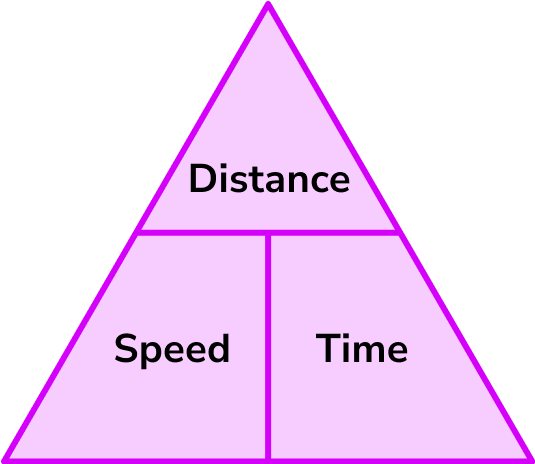
From this triangle we can work out how to calculate each measure: We can ‘cover up’ what we are trying to find and the formula triangle tells us what calculation to do.
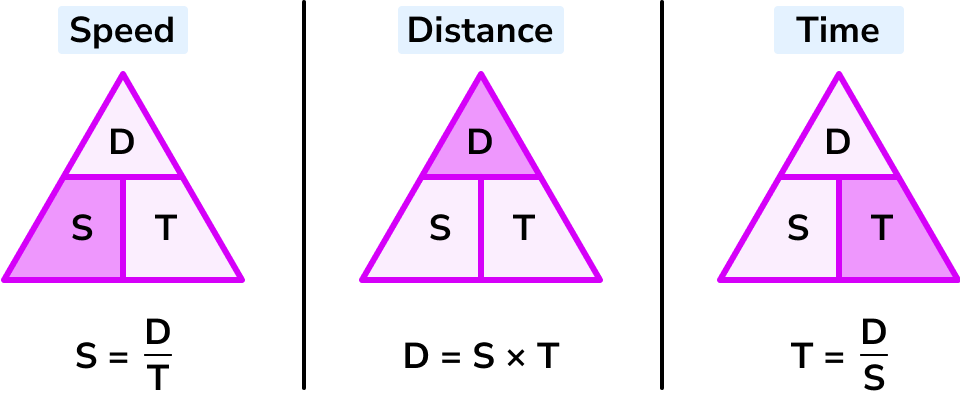
Let’s look at an example to calculate time.
How long does it take for a car to travel 34 miles at a speed of 68 miles per hour?
Let’s look at an example to calculate distance.
What distance does a bike cover if it travels at a speed of 7 metres per second for 50 seconds?
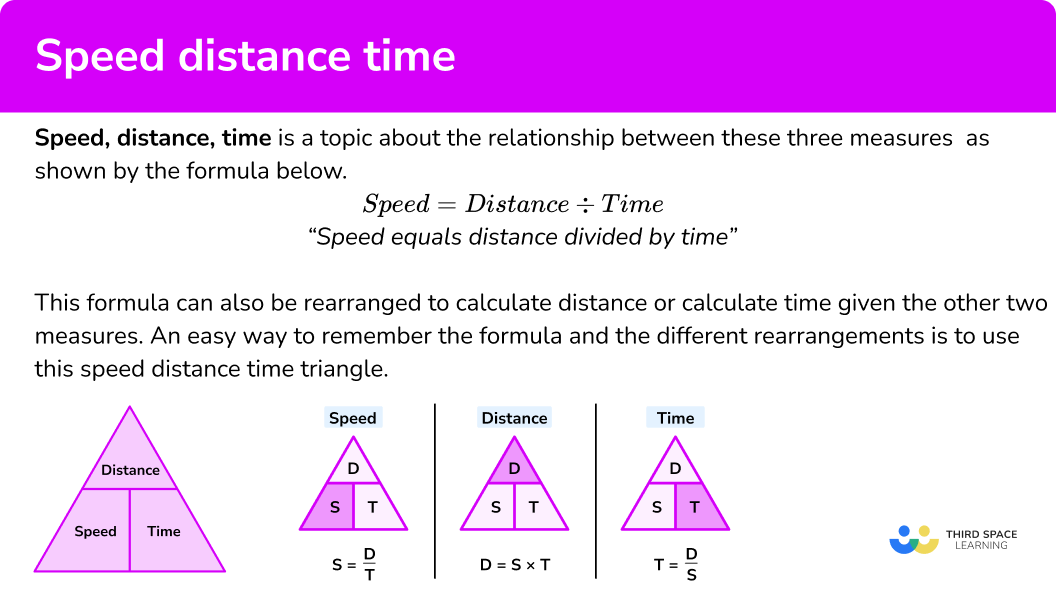
What is the speed distance time formula?
The speed distance time formula is just another way of referring to the speed distance time triangle or calculation you can use to determine speed, time or distance.
- speed = distance ÷ time
- time = distance ÷ speed
- distance = speed x time
Time problem
We can solve problems involving time by remembering the formula for speed , distance and time .
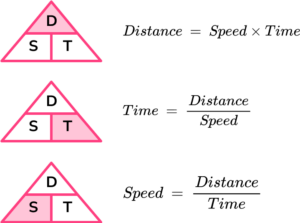
Calculate the time if a car travels at 15 miles at a speed of 36 mph.
Time = distance ÷ speed
Time = 15 ÷ 36 = 0.42 hours
0.42 ✕ 60 = 25.2 minutes
A train travels 42km between two stops at an average speed of 36 km/h.
If the train departs at 4 pm, when does the train arrive?
Time = 42 ÷ 36 = 1.17 hours
1.17 ✕ 60= 70 minutes = 1 hour 10 minutes.
The average speed of a scooter is 18 km/h and the average speed of a cycle is 10 km/h.
When both have travelled 99 km what is the difference in the time taken?
Time A = 99 ÷ 18 = 5.5 hours
Time B= 99 ÷ 10 = 9.9 hours
Difference in time = 9.9 – 5.5 = 4.4 hours
4.4 hours = 4 hours and 24 minutes
Units of speed, distance and time
- The speed of an object is the magnitude of its velocity. We measure speed most commonly in metres per second (m/s), miles per hour (mph) and kilometres per hour (km/hr).
The average speed of a small plane is 124mph.
The average walking speed of a person is 1.4m/s.
- We measure the distance an object has travelled most commonly in millimetres (mm), centimetres (cm), metres (m) and kilometres (km).
The distance from London to Birmingham is 162.54km.
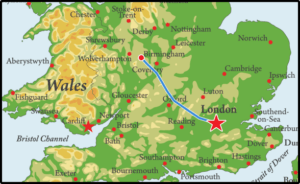
- We measure time taken in milliseconds, seconds, minutes, hours, days, weeks, months and years.
The time taken for the Earth to orbit the sun is 1 year or 365 days. We don’t measure this in smaller units like minutes of hours.
A short bus journey however, would be measured in minutes.
Speed, distance and time are proportional.
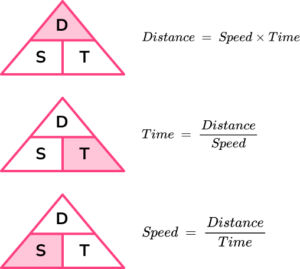
If we know two of the measurements we can find the other.
A car drives 150 miles in 3 hours.
Calculate the average speed, in mph, of the car.
Distance = 150 miles
Time = 3 hours
Speed = 150÷ 3= 50mph
Speed, distance, time and units of measure
It is very important to be aware of the units being used when calculating speed, distance and time.
- Examples of units of distance: mm, \ cm, \ m, \ km, \ miles
- Examples of units of time: seconds (sec), minutes, (mins) hours (hrs), days
- Examples of units of speed: metres per second (m/s), miles per hour (mph)
Note that speed is a compound measure and therefore involves two units; a combination of a distance in relation to a time.
When you use the speed distance time formula you must check that each measure is in the appropriate unit before you carry out the calculation. Sometimes you will need to convert a measure into different units. Here are some useful conversions to remember.
Units of length
Units of time
1 minute = 60 seconds
1 hour = 60 minutes
1 day = 24 hours
Let’s look at an example.
What distance does a bike cover if it travels at a speed of 5 metres per second for 3 minutes?
Note here that the speed involves seconds, but the time given is in minutes. So before using the formula you must change 3 minutes into seconds.
3 minutes = 3\times 60 =180 seconds
Note also that sometimes you may need to convert an answer into different units at the end of a calculation.
Constant speed / average speed
For the GCSE course you will be asked to calculate either a constant speed or an average speed . Both of these can be calculated using the same formula as shown above.
However, this terminology is used because in real life speed varies throughout a journey. You should also be familiar with the terms acceleration (getting faster) and deceleration (getting slower).
Constant speed
A part of a journey where the speed stays the same.
Average speed
A journey might involve a variety of different constant speeds and some acceleration and deceleration. We can use the formula for speed to calculate the average speed over the course of the whole journey.
Average Speed Formula
Average speed is the total distance travelled by an object divided by the total time taken. To do this we can use the formula
Average speed =\frac{Total\, distance}{Total\, time}
If we are calculating an average speed in mph or km/h, we will need to ensure we have decimalised the time before we divide.
How to calculate speed distance time
In order to calculate speed, distance or time:
Write down the values of the measures you know with the units.
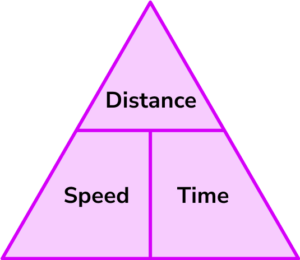
Check that the units are compatible with each other, converting them if necessary.
Substitute the values into the selected formula and carry out the resulting calculation.
Write your final answer with the required units.
Explain how to calculate speed distance time
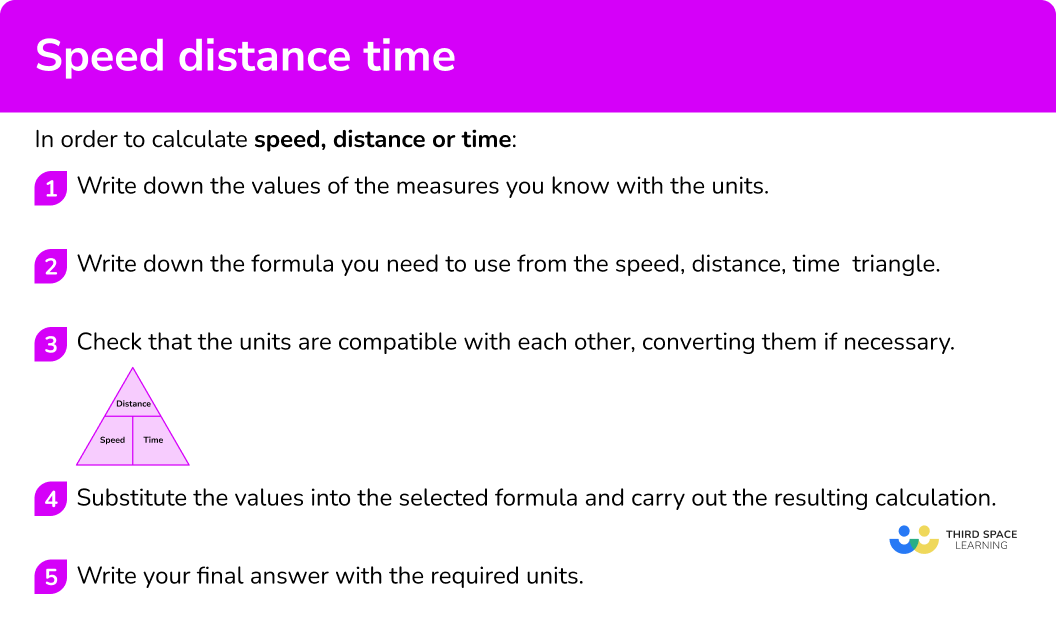
Speed distance time triangle worksheet
Get your free speed distance time triangle worksheet of 20+ questions and answers. Includes reasoning and applied questions.
Related lessons on compound measures
Speed distance time is part of our series of lessons to support revision on compound measures . You may find it helpful to start with the main compound measures lesson for a summary of what to expect, or use the step by step guides below for further detail on individual topics. Other lessons in this series include:
- Compound measures
- Mass density volume
- Pressure force area
- Formula for speed
- Average speed formula
Speed distance time triangle examples
Example 1: calculating average speed.
Calculate the average speed of a car which travels 68 miles in 2 hours.
Speed: unknown
Distance: 68 miles
Time: 2 hours
2 Write down the formula you need to use from the speed, distance, time triangle.
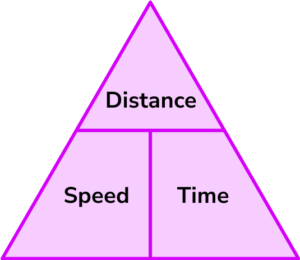
3 Check that the units are compatible with each other, converting them if necessary.
The distance is in miles and the time is in hours. These units are compatible to give the speed in miles per hour.
4 Substitute the values into the formula and carry out the resulting calculation.
5 Write your final answer with the required units.
Example 2: calculating time
A golden eagle can fly at a speed of 55 kilometres per hour. Calculate the time taken for a golden eagle to fly 66 \ km, giving your answer in hours.
Speed: 55 \ km/hour
Distance: 66 \ km
Time: unknown
Write down the formula you need to use from the speed, distance, time triangle.
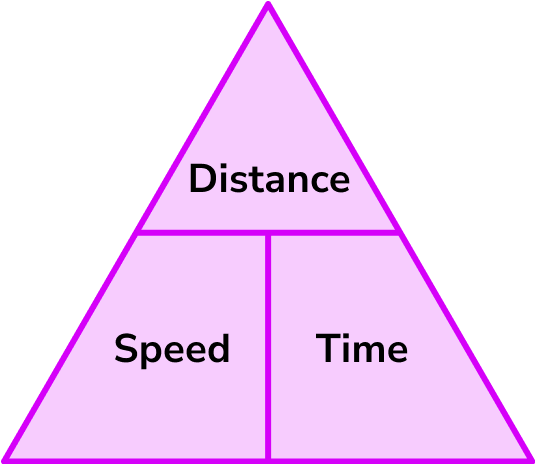
T=\frac{D}{S}
Time = distance \div speed
Speed is in km per hour and the distance is in km , so these are compatible to give an answer for time in hours.
Example 3: calculating distance
Calculate the distance covered by a train travelling at a constant speed of 112 miles per hour for 4 hours.
Speed: 112 \ mph
Distance: unknown
Time: 4 hours
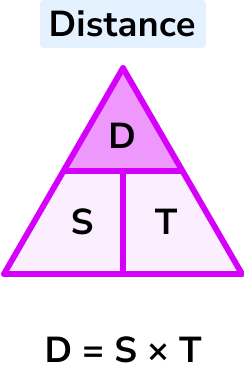
D= S \times T
Distance = speed \times time
Speed is in miles per hour. The time is in hours. These units are compatible to find the distance in miles.
Example 4: calculating speed with unit conversion
A car travels for 1 hour and 45 minutes, covering a distance of 63 miles. Calculate the average speed of the car giving your answer in miles per hour (mph) .
Distance: 63 miles
Time: 1 hour and 45 minutes
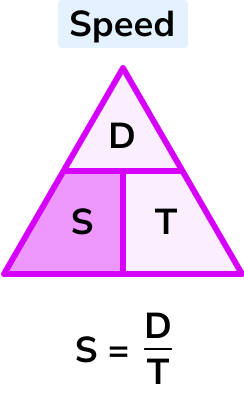
S = \frac{D}{T}
Speed = distance \div time
The distance is in miles . The time is in hours and minutes. To calculate the speed in miles per hour , the time needs to be converted into hours only.
1 hour 45 minutes = 1\frac{3}{4} hours = 1.75 hours
Example 5: calculating time with unit conversion
A small plane can travel at an average speed of 120 miles per hour. Calculate the time taken for this plane to fly 80 miles giving your answer in minutes.
Speed: 120 \ mph
Distance: 80 \ miles
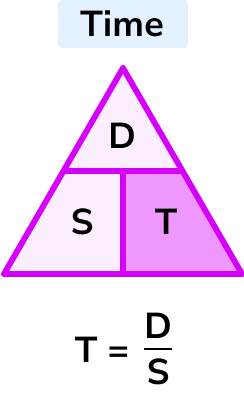
T = \frac{D}{S}
Speed is in miles per hour and the distance is in miles . These units are compatible to find the time in hours.
\frac{2}{3} hours in minutes
\frac{2}{3} \times 60 = 40
Example 6: calculating distance with unit conversion
A train travels at a constant speed of 96 miles per hour for 135 minutes. Calculate the distance covered giving your answer in miles.
Speed: 96 \ mph
Time: 135 minutes
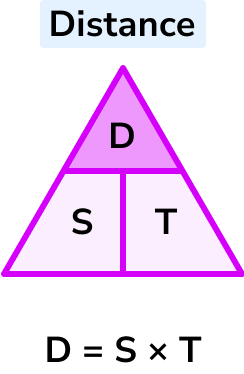
D = S \times T
The speed is in miles per hour , but the time is in minutes. To make these compatible the time needs changing into hours and then the calculation will give the distance in miles .
135 minutes
135 \div 60 = \frac{9}{4} = 2\frac{1}{4} = 2.25
Common misconceptions
- Incorrectly rearranging the formula Speed = distance \div time
Make sure you rearrange the formula correctly. One of the simplest ways of doing this is to use the formula triangle. In the triangle you cover up the measure you want to find out and then the triangle shows you what calculation to do with the other two measures.
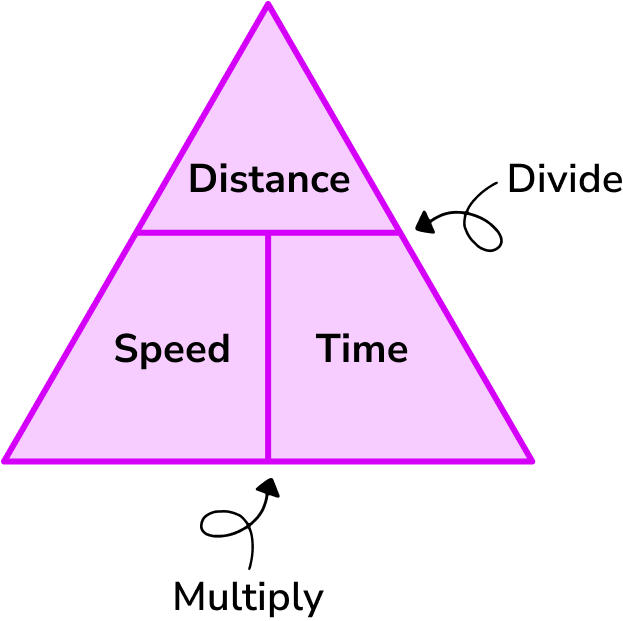
- Using incompatible units in a calculation
When using the speed distance time formula you must ensure that the units of the measures are compatible. For example, if a car travels at 80 \ km per hour for 30 minutes and you are asked to calculate the distance, a common error is to substitute the values straight into the formula and do the following calculation. Distance = speed \times time = 80 \times 30 = 2400 \ km The correct way is to notice that the speed uses hours but the time given is in minutes. Therefore you must change 30 minutes into 0.5 hours and substitute these compatible values into the formula and do the following calculation. Distance = speed \times time = 80 \times 0.5 = 40 \ km
Practice speed distance time triangle questions
1. A car drives 120 miles in 3 hours. Calculate its average speed.

2. A cyclist travels 100 miles at an average speed of 20 \ mph. Calculate how long the journey takes.
3. An eagle flies for 30 minutes at a speed of 66 \ km per hour. Calculate the total distance the bird has flown.
30 minutes = 0.5 hours
4. Calculate the average speed of a lorry travelling 54 miles in 90 minutes. Give your answer in miles per hour (mph).
Firstly convert 90 minutes to hours. 90 minutes = 1.5 hours
5. Calculate the time taken for a plane to fly 90 miles at an average speed of 120 \ mph. Give your answer in minutes.
180 minutes
Convert 0.75 hours to minutes
6. A helicopter flies 18 \ km in 20 minutes. Calculate its average speed in km/h .
Firstly convert 20 minutes to hours. 20 minutes is a third of an hour or \frac{1}{3} hours. \begin{aligned} &Speed = distance \div time \\\\ &Speed =18 \div \frac{1}{3} \\\\ &Speed = 54 \\\\ &54 \ km/h \end{aligned}
Speed distance time triangle GCSE questions
1. A commercial aircraft travels from its origin to its destination in a time of 2 hours and 15 minutes. The journey is 1462.5 \ km.
What is the average speed of the plane in km/hour?
2 hours 15 minutes = 2\frac{15}{60} = 2\frac{1}{4} = 2.25
2. John travelled 30 \ km in 90 minutes.
Nadine travelled 52.5 \ km in 2.5 hours.
Who had the greater average speed?
You must show your working.
90 minutes = 1.5 hours
John = 30 \div 1.5 = 20 \ km/h
Nadine = 52.5 \div 2.5 = 21 \ km/h
Nadine has the greater average speed.
3. The distance from Birmingham to Rugby is 40 miles.
Omar drives from Rugby to Birmingham at 60 \ mph.
Ayushi drives from Rugby to Birmingham at 50 \ mph.
How much longer was Ayushi’s journey compared to Omar’s journey? Give your answer in minutes.
For calculating time in hours for Omar or Ayushi.
For converting hours into minutes for Omar or Ayushi.
For correct final answer of 8 minutes.
Learning checklist
You have now learned how to:
- Use compound units such as speed
- Solve simple kinematic problem involving distance and speed
- Change freely between related standard units (e.g. time, length) and compound units (e.g. speed) in numerical contexts
- Work with compound units in a numerical context
The next lessons are
- Best buy maths
- Scale maths
Still stuck?
Prepare your KS4 students for maths GCSEs success with Third Space Learning. Weekly online one to one GCSE maths revision lessons delivered by expert maths tutors.

Find out more about our GCSE maths tuition programme.
Privacy Overview
Reset password New user? Sign up
Existing user? Log in
Speed, Distance, and Time
Already have an account? Log in here.
Recommended Course
Classical mechanics.
Hardcore training for the aspiring physicist.
A common set of physics problems ask students to determine either the speed, distance, or travel time of something given the other two variables. These problems are interesting since they describe very basic situations that occur regularly for many people. For example, a problem might say: "Find the distance a car has traveled in fifteen minutes if it travels at a constant speed of \(75 \text {km/hr}\)." Often in these problems, we work with an average velocity or speed, which simplifies the laws of motion used to calculate the desired quantity. Let's see how that works.
Application and Extensions
As long as the speed is constant or average, the relationship between speed , distance , and time is expressed in this equation
\[\mbox{Speed} = \frac{\mbox{Distance}}{\mbox{Time}},\]
which can also be rearranged as
\[\mbox{Time} = \frac{\mbox{Distance}}{\mbox{Speed}}\]
\[\mbox{Distance} = \mbox{Speed} \times \mbox{Time}.\]
Speed, distance, and time problems ask to solve for one of the three variables given certain information. In these problems, objects are moving at either constant speeds or average speeds.
Most problems will give values for two variables and ask for the third.
Bernie boards a train at 1:00 PM and gets off at 5:00 PM. During this trip, the train traveled 360 kilometers. What was the train's average speed in kilometers per hour? In this problem, the total time is 4 hours and the total distance is \(360\text{ km},\) which we can plug into the equation: \[\mbox{Speed} = \frac{\mbox{Distance}}{\mbox{Time}}= \frac{360~\mbox{km}}{4~\mbox{h}} = 90~\mbox{km/h}. \ _\square \]
When working with these problems, always pay attention to the units for speed, distance, and time. Converting units may be necessary to obtaining a correct answer.
A horse is trotting along at a constant speed of 8 miles per hour. How many miles will it travel in 45 minutes? The equation for calculating distance is \[\mbox{Distance} = \mbox{Speed} \times \mbox{Time},\] but we won't arrive at the correct answer if we just multiply 8 and 45 together, as the answer would be in units of \(\mbox{miles} \times \mbox{minute} / \mbox{hour}\). To fix this, we incorporate a unit conversion: \[\mbox{Distance} = \frac{8~\mbox{miles}}{~\mbox{hour}} \times 45~\mbox{minutes} \times \frac{1~\mbox{hour}}{60~\mbox{minutes}} = 6~\mbox{miles}. \ _\square \] Alternatively, we can convert the speed to units of miles per minute and calculate for distance: \[\mbox{Distance} = \frac{2}{15}~\frac{\mbox{miles}}{\mbox{minute}} \times 45~\mbox{minutes} = 6~\mbox{miles},\] or we can convert time to units of hours before calculating: \[\mbox{Distance} = 8~\frac{\mbox{miles}}{\mbox{hour}} \times \frac{3}{4}~\mbox{hours} = 6~\mbox{miles}.\] Any of these methods will give the correct units and answer. \(_\square\)
In more involved problems, it is convenient to use variables such as \(v\), \(d\), and \(t\) for speed, distance, and velocity, respectively.
Alice, Bob, Carly, and Dave are in a flying race!
Alice's plane is twice as fast as Bob's plane. When Alice finishes the race, the distance between her and Carly is \(D.\) When Bob finishes the race, the distance between him and Dave is \(D.\)
If Bob's plane is three times as fast as Carly's plane, then how many times faster is Alice's plane than Dave's plane?
Albert and Danny are running in a long-distance race. Albert runs at 6 miles per hour while Danny runs at 5 miles per hour. You may assume they run at a constant speed throughout the race. When Danny reaches the 25 mile mark, Albert is exactly 40 minutes away from finishing. What is the race's distance in miles? \[\] Let's begin by calculating how long it takes for Danny to run 25 miles: \[\mbox{Time} = \frac{\mbox{Distance}}{\mbox{Speed}}= \frac{25~\mbox{miles}}{5~\mbox{miles/hour}}= 5~\mbox{hours}.\] So, it will take Albert \(5~\mbox{hours} + 40~\mbox{minutes}\), or \(\frac{17}{3}~\mbox{hours}\), to finish the race. Now we can calculate the race's distance: \[\begin{align} \mbox{Distance} &= \mbox{Speed} \times \mbox{Time} \\ &= (6~\mbox{miles/hour}) \times \left(\frac{17}{3}~\mbox{hours}\right) \\ &= 34~\mbox{miles}.\ _\square \end{align}\]
A cheetah spots a gazelle \(300\text{ m}\) away and sprints towards it at \(100\text{ km/h}.\) At the same time, the gazelle runs away from the cheetah at \(80\text{ km/h}.\) How many seconds does it take for the cheetah to catch the gazelle? \[\] Let's set up equations representing the distance the cheetah travels and the distance the gazelle travels. If we set distance \(d\) equal to \(0\) as the cheetah's starting point, we have \[\begin{align} d_\text{cheetah} &= 100t \\ d_\text{gazelle} &= 0.3 + 80t. \end{align}\] Note that time \(t\) here is in units of hours, and \(300\text{ m}\) was converted to \(0.3\text{ km}.\) The cheetah catches the gazelle when \[\begin{align} d_\text{cheetah} &=d_\text{gazelle} \\ 100t &= 0.3 + 80t \\ 20t &= 0.3 \\ t &= 0.015~\mbox{hours}. \end{align}\] Converting that answer to seconds, we find that the cheetah catches the gazelle in \(54~\mbox{seconds}\). \(_\square\)
Two friends are crossing a hundred meter railroad bridge when they suddenly hear a train whistle. Desperate, each friend starts running, one towards the train and one away from the train. The one that ran towards the train gets to safety just before the train passes, and so does the one that ran in the same direction as the train.
If the train is five times faster than each friend, then what is the train-to-friends distance when the train whistled (in meters)?

Master concepts like these
Learn more in our Classical Mechanics course, built by experts for you.
Problem Loading...
Note Loading...
Set Loading...

- Math Forum/Help
- Problem Solver
- College Math
- Word Problems
Math Word Problems and Solutions - Distance, Speed, Time
Problem 1 A salesman sold twice as much pears in the afternoon than in the morning. If he sold 360 kilograms of pears that day, how many kilograms did he sell in the morning and how many in the afternoon? Click to see solution Solution: Let $x$ be the number of kilograms he sold in the morning.Then in the afternoon he sold $2x$ kilograms. So, the total is $x + 2x = 3x$. This must be equal to 360. $3x = 360$ $x = \frac{360}{3}$ $x = 120$ Therefore, the salesman sold 120 kg in the morning and $2\cdot 120 = 240$ kg in the afternoon.
Problem 2 Mary, Peter, and Lucy were picking chestnuts. Mary picked twice as much chestnuts than Peter. Lucy picked 2 kg more than Peter. Together the three of them picked 26 kg of chestnuts. How many kilograms did each of them pick? Click to see solution Solution: Let $x$ be the amount Peter picked. Then Mary and Lucy picked $2x$ and $x+2$, respectively. So $x+2x+x+2=26$ $4x=24$ $x=6$ Therefore, Peter, Mary, and Lucy picked 6, 12, and 8 kg, respectively.
Problem 3 Sophia finished $\frac{2}{3}$ of a book. She calculated that she finished 90 more pages than she has yet to read. How long is her book? Click to see solution Solution: Let $x$ be the total number of pages in the book, then she finished $\frac{2}{3}\cdot x$ pages. Then she has $x-\frac{2}{3}\cdot x=\frac{1}{3}\cdot x$ pages left. $\frac{2}{3}\cdot x-\frac{1}{3}\cdot x=90$ $\frac{1}{3}\cdot x=90$ $x=270$ So the book is 270 pages long.
Problem 4 A farming field can be ploughed by 6 tractors in 4 days. When 6 tractors work together, each of them ploughs 120 hectares a day. If two of the tractors were moved to another field, then the remaining 4 tractors could plough the same field in 5 days. How many hectares a day would one tractor plough then? Click to see solution Solution: If each of $6$ tractors ploughed $120$ hectares a day and they finished the work in $4$ days, then the whole field is: $120\cdot 6 \cdot 4 = 720 \cdot 4 = 2880$ hectares. Let's suppose that each of the four tractors ploughed $x$ hectares a day. Therefore in 5 days they ploughed $5 \cdot 4 \cdot x = 20 \cdot x$ hectares, which equals the area of the whole field, 2880 hectares. So, we get $20x = 2880$ $ x = \frac{2880}{20} = 144$. Hence, each of the four tractors would plough 144 hectares a day.
Problem 5 A student chose a number, multiplied it by 2, then subtracted 138 from the result and got 102. What was the number he chose? Click to see solution Solution: Let $x$ be the number he chose, then $2\cdot x - 138 = 102$ $2x = 240$ $x = 120$
Problem 6 I chose a number and divide it by 5. Then I subtracted 154 from the result and got 6. What was the number I chose? Click to see solution Solution: Let $x$ be the number I chose, then $\frac{x}{5}-154=6$ $\frac{x}{5}=160$ $x=800$
| V (km/hr) | t (hr) | S (km) | |
| Car | x + 5 | 4 | 4(x +5) |
| Truck | X | 4 | 4x |
Problem 8 One side of a rectangle is 3 cm shorter than the other side. If we increase the length of each side by 1 cm, then the area of the rectangle will increase by 18 cm 2 . Find the lengths of all sides. Click to see solution Solution: Let $x$ be the length of the longer side $x \gt 3$, then the other side's length is $x-3$ cm. Then the area is S 1 = x(x - 3) cm 2 . After we increase the lengths of the sides they will become $(x +1)$ and $(x - 3 + 1) = (x - 2)$ cm long. Hence the area of the new rectangle will be $A_2 = (x + 1)\cdot(x - 2)$ cm 2 , which is 18 cm 2 more than the first area. Therefore $A_1 +18 = A_2$ $x(x - 3) + 18 = (x + 1)(x - 2)$ $x^2 - 3x + 18 = x^2 + x - 2x - 2$ $2x = 20$ $x = 10$. So, the sides of the rectangle are $10$ cm and $(10 - 3) = 7$ cm long.
Problem 9 The first year, two cows produced 8100 litres of milk. The second year their production increased by 15% and 10% respectively, and the total amount of milk increased to 9100 litres a year. How many litres were milked from each cow each year? Click to see solution Solution: Let x be the amount of milk the first cow produced during the first year. Then the second cow produced $(8100 - x)$ litres of milk that year. The second year, each cow produced the same amount of milk as they did the first year plus the increase of $15\%$ or $10\%$. So $8100 + \frac{15}{100}\cdot x + \frac{10}{100} \cdot (8100 - x) = 9100$ Therefore $8100 + \frac{3}{20}x + \frac{1}{10}(8100 - x) = 9100$ $\frac{1}{20}x = 190$ $x = 3800$ Therefore, the cows produced 3800 and 4300 litres of milk the first year, and $4370$ and $4730$ litres of milk the second year, respectively.
Problem 10 The distance between stations A and B is 148 km. An express train left station A towards station B with the speed of 80 km/hr. At the same time, a freight train left station B towards station A with the speed of 36 km/hr. They met at station C at 12 pm, and by that time the express train stopped at at intermediate station for 10 min and the freight train stopped for 5 min. Find: a) The distance between stations C and B. b) The time when the freight train left station B. Click to see solution Solution a) Let x be the distance between stations B and C. Then the distance from station C to station A is $(148 - x)$ km. By the time of the meeting at station C, the express train travelled for $\frac{148-x}{80}+\frac{10}{60}$ hours and the freight train travelled for $\frac{x}{36}+\frac{5}{60}$ hours. The trains left at the same time, so: $\frac{148 - x}{80} + \frac{1}{6} = \frac{x}{36} + \frac{1}{12}$. The common denominator for 6, 12, 36, 80 is 720. Then $9(148 - x) +120 = 20x +60$ $1332 - 9x + 120 = 20x + 60$ $29x = 1392$ $x = 48$. Therefore the distance between stations B and C is 48 km. b) By the time of the meeting at station C the freight train rode for $\frac{48}{36} + \frac{5}{60}$ hours, i.e. $1$ hour and $25$ min. Therefore it left station B at $12 - (1 + \frac{25}{60}) = 10 + \frac{35}{60}$ hours, i.e. at 10:35 am.
Problem 11 Susan drives from city A to city B. After two hours of driving she noticed that she covered 80 km and calculated that, if she continued driving at the same speed, she would end up been 15 minutes late. So she increased her speed by 10 km/hr and she arrived at city B 36 minutes earlier than she planned. Find the distance between cities A and B. Click to see solution Solution: Let $x$ be the distance between A and B. Since Susan covered 80 km in 2 hours, her speed was $V = \frac{80}{2} = 40$ km/hr. If she continued at the same speed she would be $15$ minutes late, i.e. the planned time on the road is $\frac{x}{40} - \frac{15}{60}$ hr. The rest of the distance is $(x - 80)$ km. $V = 40 + 10 = 50$ km/hr. So, she covered the distance between A and B in $2 +\frac{x - 80}{50}$ hr, and it was 36 min less than planned. Therefore, the planned time was $2 + \frac{x -80}{50} + \frac{36}{60}$. When we equalize the expressions for the scheduled time, we get the equation: $\frac{x}{40} - \frac{15}{60} = 2 + \frac{x -80}{50} + \frac{36}{60}$ $\frac{x - 10}{40} = \frac{100 + x - 80 + 30}{50}$ $\frac{x - 10}{4} = \frac{x +50}{5}$ $5x - 50 = 4x + 200$ $x = 250$ So, the distance between cities A and B is 250 km.
Problem 12 To deliver an order on time, a company has to make 25 parts a day. After making 25 parts per day for 3 days, the company started to produce 5 more parts per day, and by the last day of work 100 more parts than planned were produced. Find how many parts the company made and how many days this took. Click to see solution Solution: Let $x$ be the number of days the company worked. Then 25x is the number of parts they planned to make. At the new production rate they made: $3\cdot 25 + (x - 3)\cdot 30 = 75 + 30(x - 3)$ Therefore: $25 x = 75 + 30(x -3) - 100$ $25x = 75 +30x -90 - 100$ $190 -75 = 30x -25$ $115 = 5x$ $x = 23$ So the company worked 23 days and they made $23\cdot 25+100 = 675$ pieces.
Problem 13 There are 24 students in a seventh grade class. They decided to plant birches and roses at the school's backyard. While each girl planted 3 roses, every three boys planted 1 birch. By the end of the day they planted $24$ plants. How many birches and roses were planted? Click to see solution Solution: Let $x$ be the number of roses. Then the number of birches is $24 - x$, and the number of boys is $3\times (24-x)$. If each girl planted 3 roses, there are $\frac{x}{3}$ girls in the class. We know that there are 24 students in the class. Therefore $\frac{x}{3} + 3(24 - x) = 24$ $x + 9(24 - x) = 3\cdot 24$ $x +216 - 9x = 72$ $216 - 72 = 8x$ $\frac{144}{8} = x$ $x = 18$ So, students planted 18 roses and 24 - x = 24 - 18 = 6 birches.
Problem 14 A car left town A towards town B driving at a speed of V = 32 km/hr. After 3 hours on the road the driver stopped for 15 min in town C. Because of a closed road he had to change his route, making the trip 28 km longer. He increased his speed to V = 40 km/hr but still he was 30 min late. Find: a) The distance the car has covered. b) The time that took it to get from C to B. Click to see solution Solution: From the statement of the problem we don't know if the 15 min stop in town C was planned or it was unexpected. So we have to consider both cases. A The stop was planned. Let us consider only the trip from C to B, and let $x$ be the number of hours the driver spent on this trip. Then the distance from C to B is $S = 40\cdot x$ km. If the driver could use the initial route, it would take him $x - \frac{30}{60} = x - \frac{1}{2}$ hours to drive from C to B. The distance from C to B according to the initially itinerary was $(x - \frac{1}{2})\cdot 32$ km, and this distance is $28$ km shorter than $40\cdot x$ km. Then we have the equation $(x - 1/2)\cdot 32 + 28 = 40x$ $32x -16 +28 = 40x$ $-8x = -12$ $8x = 12$ $x = \frac{12}{8}$ $x = 1 \frac{4}{8} = 1 \frac{1}{2} = 1 \frac{30}{60} =$ 1 hr 30 min. So, the car covered the distance between C and B in 1 hour and 30 min. The distance from A to B is $3\cdot 32 + \frac{12}{8}\cdot 40 = 96 + 60 = 156$ km. B Suppose it took $x$ hours for him to get from C to B. Then the distance is $S = 40\cdot x$ km. The driver did not plan the stop at C. Let we accept that he stopped because he had to change the route. It took $x - \frac{30}{60} + \frac{15}{60} = x - \frac{15}{60} = x - \frac{1}{4}$ h to drive from C to B. The distance from C to B is $32(x - \frac{1}{4})$ km, which is $28$ km shorter than $40\cdot x$, i.e. $32(x - \frac{1}{4}) + 28 = 40x$ $32x - 8 +28 = 40x$ $20= 8x$ $x = \frac{20}{8} = \frac{5}{2} = 2 \text{hr } 30 \text{min}.$ The distance covered equals $ 40 \times 2.5 = 100 km$.
Problem 15 If a farmer wants to plough a farm field on time, he must plough 120 hectares a day. For technical reasons he ploughed only 85 hectares a day, hence he had to plough 2 more days than he planned and he still has 40 hectares left. What is the area of the farm field and how many days the farmer planned to work initially? Click to see solution Solution: Let $x$ be the number of days in the initial plan. Therefore, the whole field is $120\cdot x$ hectares. The farmer had to work for $x + 2$ days, and he ploughed $85(x + 2)$ hectares, leaving $40$ hectares unploughed. Then we have the equation: $120x = 85(x + 2) + 40$ $35x = 210$ $x = 6$ So the farmer planned to have the work done in 6 days, and the area of the farm field is $120\cdot 6 = 720$ hectares.
Problem 16 A woodworker normally makes a certain number of parts in 24 days. But he was able to increase his productivity by 5 parts per day, and so he not only finished the job in only 22 days but also he made 80 extra parts. How many parts does the woodworker normally makes per day and how many pieces does he make in 24 days? Click to see solution Solution: Let $x$ be the number of parts the woodworker normally makes daily. In 24 days he makes $24\cdot x$ pieces. His new daily production rate is $x + 5$ pieces and in $22$ days he made $22 \cdot (x + 5)$ parts. This is 80 more than $24\cdot x$. Therefore the equation is: $24\cdot x + 80 = 22(x +5)$ $30 = 2x$ $x = 15$ Normally he makes 15 parts a day and in 24 days he makes $15 \cdot 24 = 360$ parts.
Problem 17 A biker covered half the distance between two towns in 2 hr 30 min. After that he increased his speed by 2 km/hr. He covered the second half of the distance in 2 hr 20 min. Find the distance between the two towns and the initial speed of the biker. Click to see solution Solution: Let x km/hr be the initial speed of the biker, then his speed during the second part of the trip is x + 2 km/hr. Half the distance between two cities equals $2\frac{30}{60} \cdot x$ km and $2\frac{20}{60} \cdot (x + 2)$ km. From the equation: $2\frac{30}{60} \cdot x = 2\frac{20}{60} \cdot (x+2)$ we get $x = 28$ km/hr. The intial speed of the biker is 28 km/h. Half the distance between the two towns is $2 h 30 min \times 28 = 2.5 \times 28 = 70$. So the distance is $2 \times 70 = 140$ km.
Problem 18 A train covered half of the distance between stations A and B at the speed of 48 km/hr, but then it had to stop for 15 min. To make up for the delay, it increased its speed by $\frac{5}{3}$ m/sec and it arrived to station B on time. Find the distance between the two stations and the speed of the train after the stop. Click to see solution Solution: First let us determine the speed of the train after the stop. The speed was increased by $\frac{5}{3}$ m/sec $= \frac{5\cdot 60\cdot 60}{\frac{3}{1000}}$ km/hr = $6$ km/hr. Therefore, the new speed is $48 + 6 = 54$ km/hr. If it took $x$ hours to cover the first half of the distance, then it took $x - \frac{15}{60} = x - 0.25$ hr to cover the second part. So the equation is: $48 \cdot x = 54 \cdot (x - 0.25)$ $48 \cdot x = 54 \cdot x - 54\cdot 0.25$ $48 \cdot x - 54 \cdot x = - 13.5$ $-6x = - 13.5$ $x = 2.25$ h. The whole distance is $2 \times 48 \times 2.25 = 216$ km.
Problem 19 Elizabeth can get a certain job done in 15 days, and Tony can finish only 75% of that job within the same time. Tony worked alone for several days and then Elizabeth joined him, so they finished the rest of the job in 6 days, working together. For how many days have each of them worked and what percentage of the job have each of them completed? Click to see solution Solution: First we will find the daily productivity of every worker. If we consider the whole job as unit (1), Elizabeth does $\frac{1}{15}$ of the job per day and Tony does $75\%$ of $\frac{1}{15}$, i.e. $\frac{75}{100}\cdot \frac{1}{15} = \frac{1}{20}$. Suppose that Tony worked alone for $x$ days. Then he finished $\frac{x}{20}$ of the total job alone. Working together for 6 days, the two workers finished $6\cdot (\frac{1}{15}+\frac{1}{20}) = 6\cdot \frac{7}{60} = \frac{7}{10}$ of the job. The sum of $\frac{x}{20}$ and $\frac{7}{10}$ gives us the whole job, i.e. $1$. So we get the equation: $\frac{x}{20}+\frac{7}{10}=1$ $\frac{x}{20} = \frac{3}{10}$ $x = 6$. Tony worked for 6 + 6 = 12 days and Elizabeth worked for $6$ days. The part of job done is $12\cdot \frac{1}{20} = \frac{60}{100} = 60\%$ for Tony, and $6\cdot \frac{1}{15} = \frac{40}{100} = 40\%$ for Elizabeth.
Problem 20 A farmer planned to plough a field by doing 120 hectares a day. After two days of work he increased his daily productivity by 25% and he finished the job two days ahead of schedule. a) What is the area of the field? b) In how many days did the farmer get the job done? c) In how many days did the farmer plan to get the job done? Click to see solution Solution: First of all we will find the new daily productivity of the farmer in hectares per day: 25% of 120 hectares is $\frac{25}{100} \cdot 120 = 30$ hectares, therefore $120 + 30 = 150$ hectares is the new daily productivity. Lets x be the planned number of days allotted for the job. Then the farm is $120\cdot x$ hectares. On the other hand, we get the same area if we add $120 \cdot 2$ hectares to $150(x -4)$ hectares. Then we get the equation $120x = 120\cdot 2 + 150(x -4)$ $x = 12$ So, the job was initially supposed to take 12 days, but actually the field was ploughed in 12 - 2 =10 days. The field's area is $120 \cdot 12 = 1440$ hectares.
Problem 21 To mow a grass field a team of mowers planned to cover 15 hectares a day. After 4 working days they increased the daily productivity by $33 \times \frac{1}{3}\%$, and finished the work 1 day earlier than it was planned. A) What is the area of the grass field? B) How many days did it take to mow the whole field? C) How many days were scheduled initially for this job? Hint : See problem 20 and solve by yourself. Answer: A) 120 hectares; B) 7 days; C) 8 days.
Problem 22 A train travels from station A to station B. If the train leaves station A and makes 75 km/hr, it arrives at station B 48 minutes ahead of scheduled. If it made 50 km/hr, then by the scheduled time of arrival it would still have 40 km more to go to station B. Find: A) The distance between the two stations; B) The time it takes the train to travel from A to B according to the schedule; C) The speed of the train when it's on schedule. Click to see solution Solution: Let $x$ be the scheduled time for the trip from A to B. Then the distance between A and B can be found in two ways. On one hand, this distance equals $75(x - \frac{48}{60})$ km. On the other hand, it is $50x + 40$ km. So we get the equation: $75(x - \frac{48}{60}) = 50x + 40$ $x = 4$ hr is the scheduled travel time. The distance between the two stations is $50\cdot 4 +40 = 240$ km. Then the speed the train must keep to be on schedule is $\frac{240}{4} = 60$ km/hr.
Problem 23 The distance between towns A and B is 300 km. One train departs from town A and another train departs from town B, both leaving at the same moment of time and heading towards each other. We know that one of them is 10 km/hr faster than the other. Find the speeds of both trains if 2 hours after their departure the distance between them is 40 km. Click to see solution Solution: Let the speed of the slower train be $x$ km/hr. Then the speed of the faster train is $(x + 10)$ km/hr. In 2 hours they cover $2x$ km and $2(x +10)$km, respectively. Therefore if they didn't meet yet, the whole distance from A to B is $2x + 2(x +10) +40 = 4x +60$ km. However, if they already met and continued to move, the distance would be $2x + 2(x + 10) - 40 = 4x - 20$km. So we get the following equations: $4x + 60 = 300$ $4x = 240$ $x = 60$ or $4x - 20 = 300$ $4x = 320$ $x = 80$ Hence the speed of the slower train is $60$ km/hr or $80$ km/hr and the speed of the faster train is $70$ km/hr or $90$ km/hr.
Problem 24 A bus travels from town A to town B. If the bus's speed is 50 km/hr, it will arrive in town B 42 min later than scheduled. If the bus increases its speed by $\frac{50}{9}$ m/sec, it will arrive in town B 30 min earlier than scheduled. Find: A) The distance between the two towns; B) The bus's scheduled time of arrival in B; C) The speed of the bus when it's on schedule. Click to see solution Solution: First we will determine the speed of the bus following its increase. The speed is increased by $\frac{50}{9}$ m/sec $= \frac{50\cdot60\cdot60}{\frac{9}{1000}}$ km/hr $= 20$ km/hr. Therefore, the new speed is $V = 50 + 20 = 70$ km/hr. If $x$ is the number of hours according to the schedule, then at the speed of 50 km/hr the bus travels from A to B within $(x +\frac{42}{60})$ hr. When the speed of the bus is $V = 70$ km/hr, the travel time is $x - \frac{30}{60}$ hr. Then $50(x +\frac{42}{60}) = 70(x-\frac{30}{60})$ $5(x+\frac{7}{10}) = 7(x-\frac{1}{2})$ $\frac{7}{2} + \frac{7}{2} = 7x -5x$ $2x = 7$ $x = \frac{7}{2}$ hr. So, the bus is scheduled to make the trip in $3$ hr $30$ min. The distance between the two towns is $70(\frac{7}{2} - \frac{1}{2}) = 70\cdot 3 = 210$ km and the scheduled speed is $\frac{210}{\frac{7}{2}} = 60$ km/hr.

Child Login
- Kindergarten
- Number charts
- Skip Counting
- Place Value
- Number Lines
- Subtraction
- Multiplication
- Word Problems
- Comparing Numbers
- Ordering Numbers
- Odd and Even
- Prime and Composite
- Roman Numerals
- Ordinal Numbers
- In and Out Boxes
- Number System Conversions
- More Number Sense Worksheets
- Size Comparison
- Measuring Length
- Metric Unit Conversion
- Customary Unit Conversion
- Temperature
- More Measurement Worksheets
- Writing Checks
- Profit and Loss
- Simple Interest
- Compound Interest
- Tally Marks
- Mean, Median, Mode, Range
- Mean Absolute Deviation
- Stem-and-leaf Plot
- Box-and-whisker Plot
- Permutation and Combination
- Probability
- Venn Diagram
- More Statistics Worksheets
- Shapes - 2D
- Shapes - 3D
- Lines, Rays and Line Segments
- Points, Lines and Planes
- Transformation
- Quadrilateral
- Ordered Pairs
- Midpoint Formula
- Distance Formula
- Parallel, Perpendicular and Intersecting Lines
- Scale Factor
- Surface Area
- Pythagorean Theorem
- More Geometry Worksheets
- Converting between Fractions and Decimals
- Significant Figures
- Convert between Fractions, Decimals, and Percents
- Proportions
- Direct and Inverse Variation
- Order of Operations
- Squaring Numbers
- Square Roots
- Scientific Notations
- Speed, Distance, and Time
- Absolute Value
- More Pre-Algebra Worksheets
- Translating Algebraic Phrases
- Evaluating Algebraic Expressions
- Simplifying Algebraic Expressions
- Algebraic Identities
- Quadratic Equations
- Systems of Equations
- Polynomials
- Inequalities
- Sequence and Series
- Complex Numbers
- More Algebra Worksheets
- Trigonometry
- Math Workbooks
- English Language Arts
- Summer Review Packets
- Social Studies
- Holidays and Events
- Worksheets >
- Pre-Algebra >
Speed, Distance, and Time Worksheets
Pacy and fun, our pdf speed, distance, and time worksheets ensure children in grade 6, grade 7, and grade 8 have what it takes to remain well ahead of their peers! Let them use the given measures and apply the correct formula to obtain the unknown measure. Hold the child spellbound with sure-to-help-upskill printables that drive them to complete the tables, answer MCQs, solve word problems, and compare speeds. Step in and take the helms with our free speed, time, and distance worksheets!
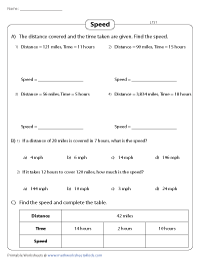
Finding the Speed | Level 1
Remind the learners that speed = distance / time. Children must write the speeds, choose the correct alternatives while answering MCQs, and complete the table by working out the missing measures.
- Download the set
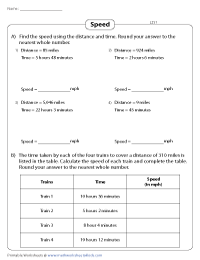
Finding the Speed | Level 2
A moderately difficult pdf worksheet, this resource empowers children to find speed hammer and tongs. Help them effectively divide the distance by time and round the speed to the nearest whole number.
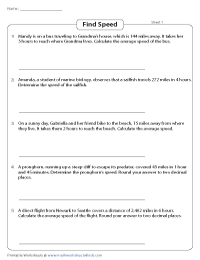
Finding the Speed | Word Problems
Watch your practice flourish with a flurry of problems in finding the rate which a person or object covers a distance at! Divide the distance covered by the time taken to obtain the speed in these printables.
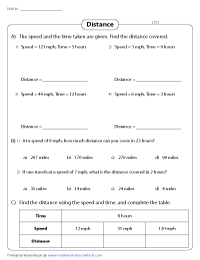
Finding the Distance | Level 1
Students know that distance = speed x time. They have bags of time to figure how to find the distance working with a bunch of easy exercises. Use the included answer key to double-check the solutions.
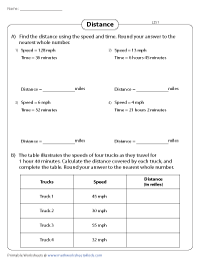
Finding the Distance | Level 2
Introduce 7th grade and 8th grade learners to these pdf worksheets and let them solve intriguing exercises involving 2-digit and 3-digit speeds. This level includes the time format X hours Y minutes.
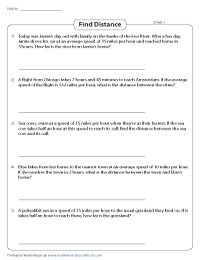
Finding the Distance | Word Problems
Get children aspiring to grab more of our speed, distance, and time worksheets to calculate the distance given the speed and time. Interactive and easy, the word problems draw on real-life scenarios.
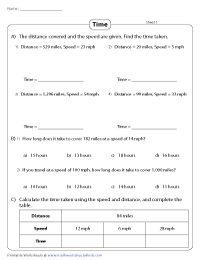
Finding the Time
How easy is it to find the time when the speed and distance are known? Check it out! Practice finding the time by employing the formula time = distance / speed and remain head and shoulders above others.
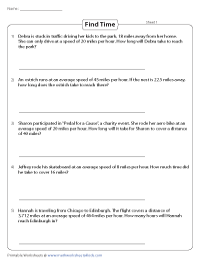
Finding the Time | Word Problems
It’s time to test skills in finding the time using distance and speed! Get tons of realistic scenarios to calculate the time taken. Our word problems, a breath of fresh air, help hammer home the concept of time!
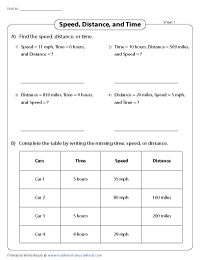
Mixed Revision Worksheets
Blend learning with excitement with this section of speed, distance, and time worksheets! Guide children to find one of the three measures given the other two. Be as consistent and correct as possible.
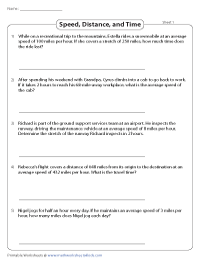
Mixed Revision | Word Problems
An eclectic mix of word problems, these printable mixed revision worksheets ensure students are on the ball from the get-go! Read each problem, analyze the given measures, and find the unknown one.
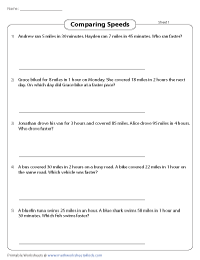
Comparing Speeds
Set grade 6, grade 7, and grade 8 children an exciting challenge to solve exercises and compare speeds! These pdf tools focus on finding who (person) or which (object) is faster given the distance and time.
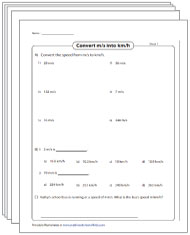
Conversion of Units of Speed
A reliable companion that makes conversion among speeds - m/s, km/h, and mph - a breeze, these printables are teeming with a mix of easy and difficult exercises. Stay attentive as you forge ahead!
(15 Worksheets)
Related Worksheets
» U.S. Customary Unit Conversion
» Metric Unit Conversion
» Time Conversion
» Solved Examples on Finding Speed
Become a Member
Membership Information
Privacy Policy
What's New?
Printing Help
Testimonial
Copyright © 2024 - Math Worksheets 4 Kids
This is a members-only feature!

SPEED DISTANCE TIME PROBLEMS WITH SOLUTIONS
Problem 1 :
A passenger train takes 3 hours less than a slow train for journey of 600 km. If the speed of the slow train is 10 km/hr less than that of the passenger train, find the speed of two trains.
Let x be the speed of the of the passenger train
Speed of the slow train is 10 km/hr less than that of the passenger train
So x-10 be the speed of the slow train
Distance has to be covered = 600 km
Time = Distance/speed
Let T 1 be the time taken by passenger train
Let T 2 be the time taken by the slow train
The differences of time taken by both trains are 3 hours
T 1 = 600/x
T 2 = 600/(x-0)
T 2 –T 1 = 3 hours
(600/(x–10)) – (600/x) = 3
600[(1/(x-10)-(1/x)] = 3
x-(x-10)/(x 2 -10x) = 1/200
(x-x+10)/(x 2 -10x) = 1/200
2000 = x 2 -10x
x 2 -10x-2000 = 0
x 2 –50x+40x-2000 = 0
x(x–50)+40(x–50) = 0
(x+40) (x–50) = 0
By solving, we get x = -40 and x = 50
Therefore the speed of passenger train = 50 km/hr
Speed of slow train = 40 m/hr.
Problem 2 :
The distance between two stations A and B is 192 km. Traveling by a fast train takes 48 minutes less than another train. Calculate the speed of the fast train if the speeds of two trains differ by 20 km/hr
Distance between two stations A and B = 192 km
Fast train takes 48 minutes less then the time taken by the slow train.
Let x be the speed taken by the fast train
Speeds of two trains differ by 20 km/hr
So speed of slow train is x – 20.
Let T 1 be the time taken by the fast train
T 1 = 192/x
T 2 = 192/(x–20)
48/60 = 4/5 hours
T 1 – T 2 = 4/5
[192/(x-20)-192/x] = 4/5
192[(x–x+20)/x(x - 20)] = 4/5
192(20)/x 2 –20 x = 4/5
3840 (5) = 4(x 2 –20 x)
19200 = 4x 2 – 80 x
4800 = x 2 – 20 x
x 2 –20x–4800 = 0
x 2 –60x+40x-4800 = 0
(x–60) (x+40) = 0
x = 60 and x = -40
Speed of fast train is 60 km/hr.
Problem 3 :
A train covers a distance of 300 km at a certain average speed. If its speed was decreased by 10km/hr, the journey would take 1 hour longer. What is the average speed.
Let x be the average speed of the train
So x–10 be the decreased speed
Time = Distance/Speed
T 1 and T 2 be the time taken by the train to cover the distance with speed of x km/hr and (x-10) km/hr respectively.
T 1 = 300/x
T 2 = 300/(x–10)
T 1 – T 2 = 1
[300/x] - [300/(x-10)] = 1
3000/(x 2 – 10x) = 1
3000 = x 2 – 10 x
x 2 – 10x = 3000
x 2 –10x–3000 = 0
x 2 –60x+50x–3000 = 0
x (x – 60) + 50 (x – 60) = 0
(x + 50)(x – 60) = 0
By solving, we get
x = -50 and x = 60
So speed of the 60 km/hr.
Problem 4 :
The time taken by a train to travel a distance of 250 km was reduced by 5/4 hours when average speed was increased by 10km/hr. Calculate the average speed.
Distance to be covered = 250 km
Let x be the required average speed.
If the average speed was increased by 10 km/hr
x+10 be the increased speed
Let T 1 be the time taken to cover the distance in the average speed of x km/hr
Let T 2 be the time taken to cover the distance in the average speed of (x + 10) km/hr
T 1 = 250/x
T 2 = 250/(x+10)
T 1 – T 2 = 5/4
250/x – 250/(x + 10) = 5/4
250 [(x+10–x)/x(x+10)] = 5/4
2500/(x 2 + 10x) = 5/4
2500 (4) = 5(x 2 +10x)
10000 = 5x 2 +10 x
Now we are going to divide the whole equation by 5, so we get
x 2 +10x = 2000
x 2 +10x–2000 = 0
x 2 + 50x-40x-2000 = 0
x(x+50)–40(x+50) = 0
(x–40) (x+50) = 0
x = 40 and x = -50
Therefore the required average speed = 40 km/hr
Increased speed = (40+10)
Problem 5 :
An express train makes run 240 km t a certain speed. Another train whose speed is 12 km/hr less takes an hour longer to make the same trip. Find the speed of the express train.
Let x be speed of express train
So x–12 be the speed of another train
Distance to be covered = 240 km
Let T 1 be the time taken by the train to cover the distance 240 km at the speed of x km/hr
Let T 2 be the time taken by the train to cover the distance 240 km at the speed of (x + 12) km/hr
Time = Distance /speed
T 1 = 240/x
T 2 = 240/(x - 12)
T 2 - T 1 = 1 hour
[240/(x- 12)] - [240/x] = 1
240[(1/(x -12) - 1/x] = 1
240[(x - x + 12)/x(x - 12)] = 1
240[12/(x 2 - 12 x)] = 1
2880 = (x 2 -12 x)
x 2 -12x-2880 = 0
x 2 +60x-48x-2880 = 0
x(x+60)- 48 (x+60) = 0
(x-48) (x+60) = 0
x = 48 x = -60
Speed of express train = 48 km/hr
Speed of other train = (x - 12)
= (48-12)
= 36 km/hr
Problem 6 :
A plane traveled a distance of 400 km at an average speed of x km/hr. On the return journey, the speed was increased by 40 km/hr. Write down an expression for the time taken for
(i) the onward journey and
(ii) the return journey. If the journey took 30 minutes less than onward journey, write down an equation in x and its value.
Let “x” be average speed of plane
On the return journey, the speed was increased by 40 km/hr
So “x + 40” be the speed of plane
Distance to be covered = 400 km
Let T 1 be the time taken for onward journey in the speed of x km/hr
Let T 2 be the time taken for downward journey to cover the same distance 400 km at the speed of (x + 40) km/hr
T 1 = 400/x
T 2 = 400/(x+40)
T 1 - T 2 = 30 minutes
[400/x]-[400/(x + 40)] = 30/60
400[(1/x) - 1/(x+40)] = 1/2
400[40/(x 2 + 40 x)] = 1/2
16000 (2) = (x 2 +40 x)
x 2 +40x-32000 = 0
x 2 +160x-100x-32000 = 0
(x - 100) (x + 160) = 0
x = 100 x = -160
Speed of the plane = 48 km/hr
Increased speed = (x+40)
= (48+40)
= 88 km/hr

Apart from the stuff given in this section , if you need any other stuff in math, please use our google custom search here.
Kindly mail your feedback to [email protected]
We always appreciate your feedback.
© All rights reserved. onlinemath4all.com
- Sat Math Practice
- SAT Math Worksheets
- PEMDAS Rule
- BODMAS rule
- GEMDAS Order of Operations
- Math Calculators
- Transformations of Functions
- Order of rotational symmetry
- Lines of symmetry
- Compound Angles
- Quantitative Aptitude Tricks
- Trigonometric ratio table
- Word Problems
- Times Table Shortcuts
- 10th CBSE solution
- PSAT Math Preparation
- Privacy Policy
- Laws of Exponents
Recent Articles
Geometry problems with solutions (part - 1).
Aug 12, 24 01:47 AM
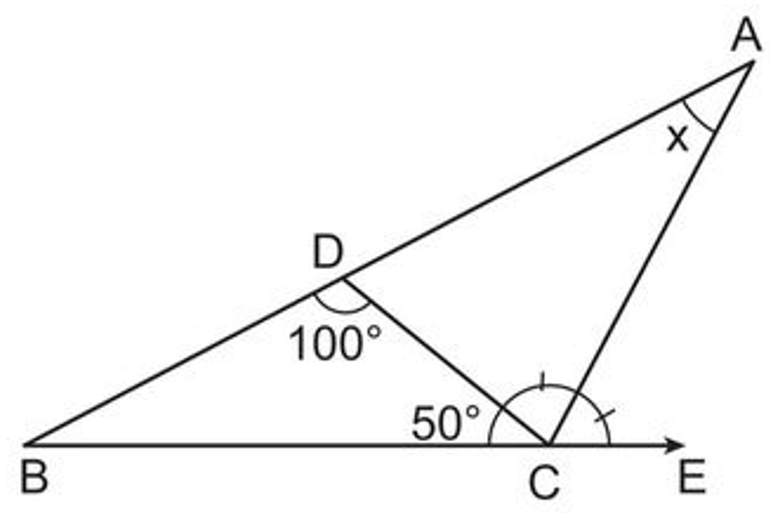
Geometry Problems with Solutions (Part - 2)
Aug 12, 24 01:44 AM
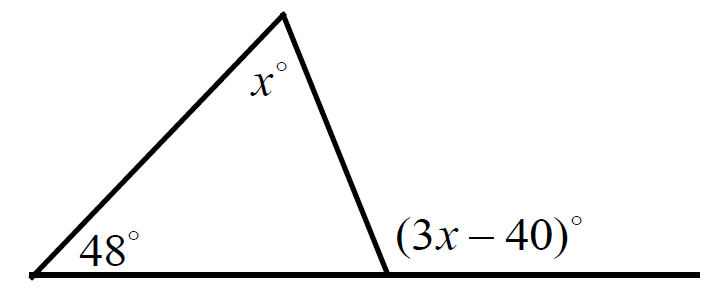
SAT Math Resources (Videos, Concepts, Worksheets and More)
Aug 11, 24 11:33 AM
Talk to our experts
1800-120-456-456
- Speed Distance Time Word Problems with Solutions

Introduction
Speed, distance, and time are the three main pillars behind mathematics and physics. Whenever you are presented with a question related to any kind of transportation, you should immediately relate to these concepts. The train speed, the relation between the time taken by two cars at different speeds or even a simple question about a person walking from one place to another can be answered using simple formulas.
What is Speed?
When you think of speed, you must think of how fast? Speed is all about calculating the rate at which something can be accomplished.
A Device Used to Measure Speed Known as a ‘Speedometer’
What is Distance?
Distance in this concept refers to the distance travelled. It means how far? It can be measured in meters, for small distances and kilometres, for larger distances.

Distance is the Measurement From One Place to Another
What is Time?
Time is the answer to the question, how long? The best way to measure time is using the ‘world clock.’ In ancient times, time was measured with the help of the sun and the moon, and other celestial objects.
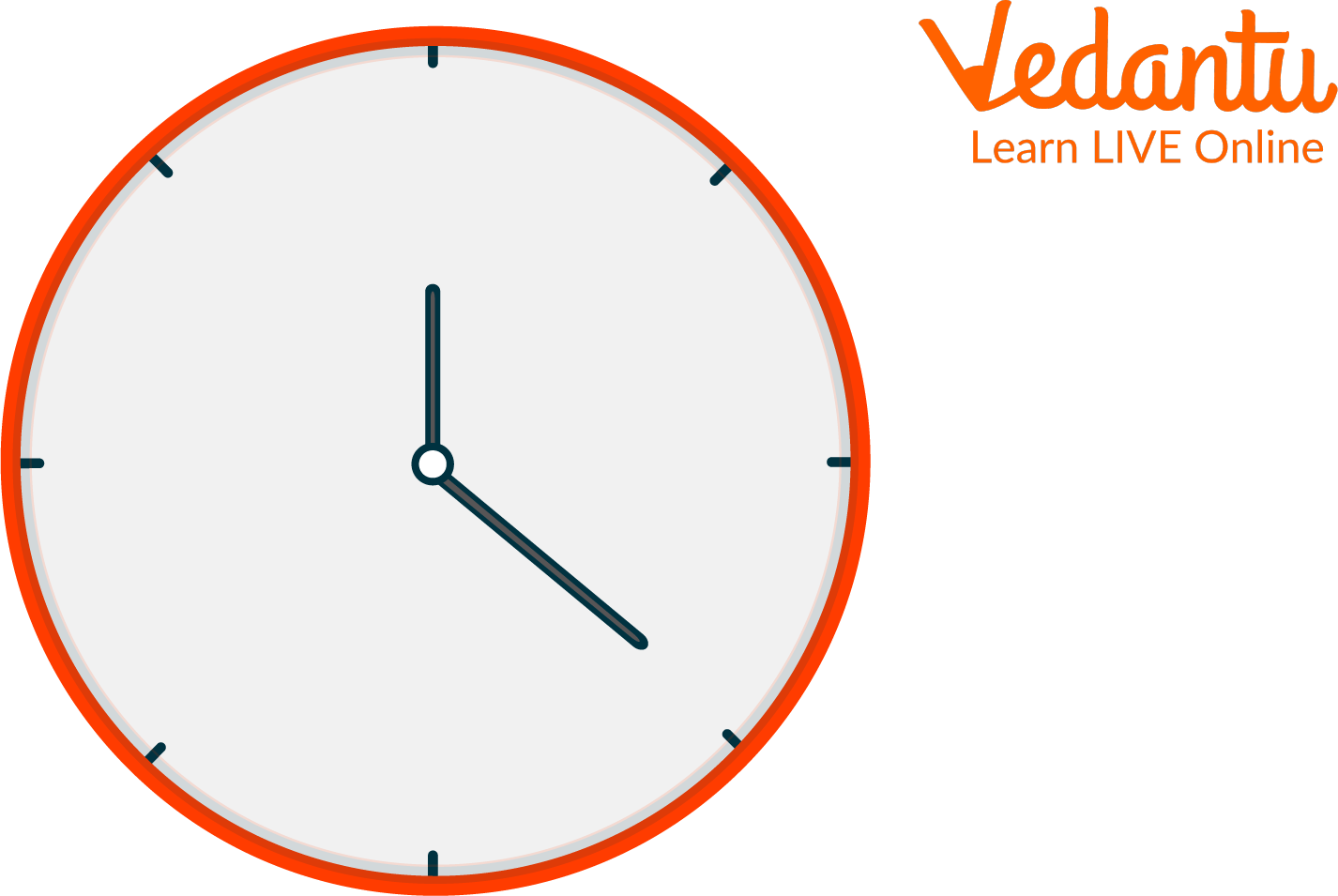
Time as Shown by a Clock
Relation Between Speed Distance and Time
There is a very simple mathematical relation between speed, distance and time.
$\text{speed=}\frac{\text{distance}}{\text{time}}$
$\text{time=}\frac{\text{distance}}{\text{speed}}$
$\text{distance=speed }\!\!\times\!\!\text{ time}$
These relations can be memorised using the triangle method. See the following image to understand the use of this method.
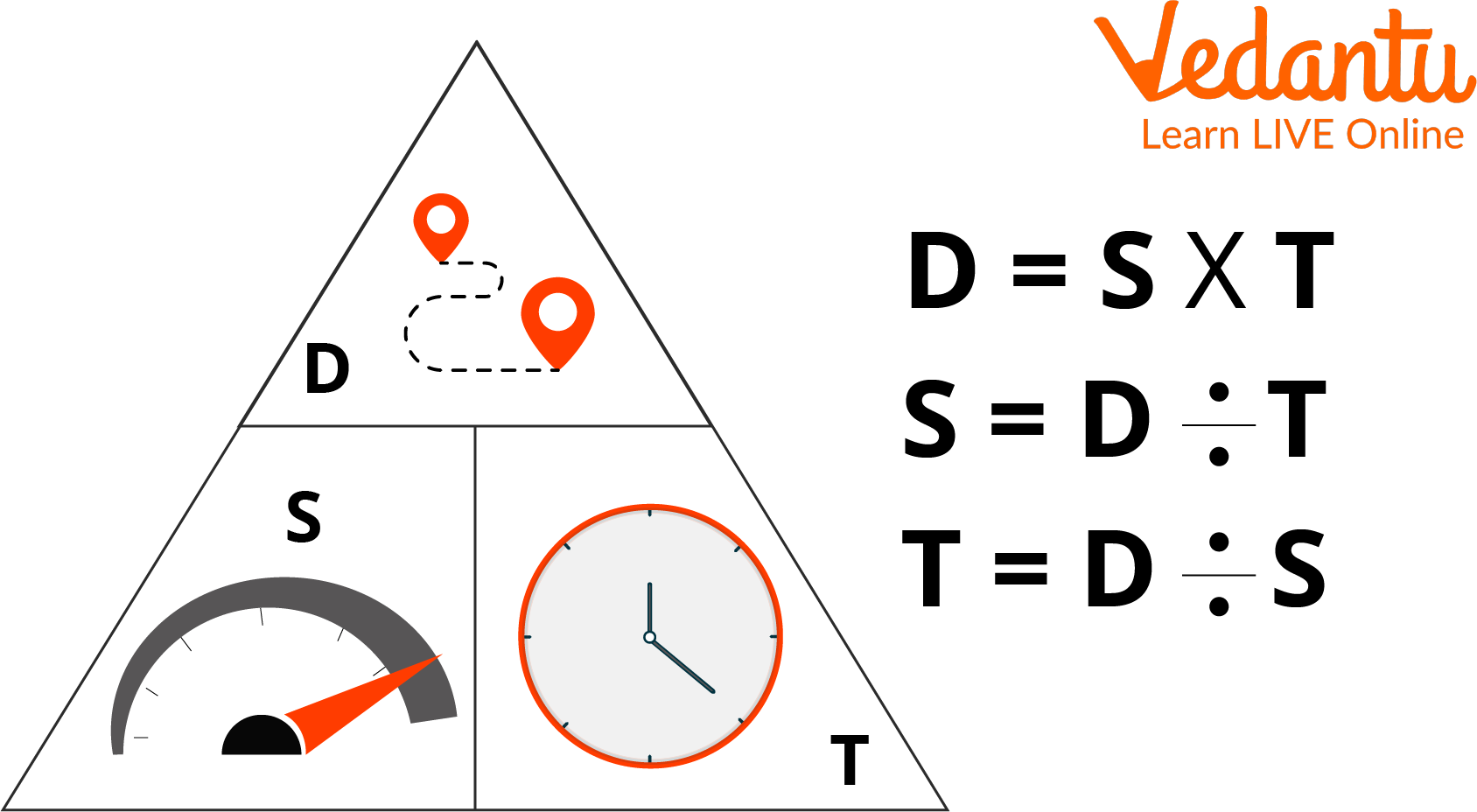
Explaining the Triangle Method
Speed Distance Time Word Problems With Solutions
Q1. A train is travelling at a speed of 160 km/hour. It takes 15 hours to cover the distance from city A to city B. Find the distance between the two cities.
Speed= 160 km/hr
Time= 15 hours
Using the formula, $\text{distance=speed }\!\!\times\!\!\text{ time}$
Distance= $160\times 15=2400km$
Answer: The distance between city A and city B is 2400km
Q2. A car travelling from city A to city C completes the journey in 3 hours, whereas a person travelling on a bike completes the journey in 5 hours. What is the speed of the man on the bike if the car is travelling at 45 kmph?
Find the distance using the information on the car
Speed= 45km/hour
Time= 3 hours
$\therefore \text{distance}=45\times 3=135km$
Using the distance, we can find the speed of the bike
Formula used, $\text{speed=}\frac{\text{distance}}{\text{time}}$
Time taken by bike is 5 hours
$\therefore \text{speed}=\frac{135}{5}=27$
Answer: The bike is moving at a speed of 27 kmph.
Q3. A person travels at a speed of 15 kmph from point A to point B, which are 25 km from each other. Another person is travelling from point C to point B, 44 km from each other. Both people start their journey at the same time; the second person arrives at the point 2 hours after the first. What is the speed at which the second person was travelling?
Speed of person 1 = 15km/hour
Distance travelled by person 1= 25 km/hour
Time taken by first-person = $\frac{\text{distance}}{\text{speed}}=\frac{25}{15}=\frac{5}{3}$hours
Note: While solving the questions, keep the answers in fractions until you reach the final answer to make calculations easier.
Time taken by second person =$\frac{5}{3}+2=\frac{11}{3}$hours
Distance travelled by second person= 44 km
$\therefore \text{speed}=\frac{\text{distance}}{\text{time}}=\frac{44}{\frac{11}{3}}=\frac{44\times 3}{11}=4\times 3=12$kmph
Answer: The second person was travelling at a speed of 12kmph.
Q4. Raju is travelling from one station to another 560km away in a train which is moving at a speed of 125kmph. Monu is travelling to the same destination at a speed of 80kmph. Monu starts his journey 3 hours after Raju, from 120 km closer to the destination. How long will Raju have to wait at the train station for Monu to arrive?
Distance travelled by Raju = 560km
Speed of Raju= 125km/hour
∴ Time taken by Raju to reach the station = $\frac{\text{distance}}{\text{speed}}=\frac{560}{125}=\frac{112}{25}$hours
Distance travelled by Monu = $560-120=440$km
The speed at which Monu travelled = 80kmph
Time taken by Monu to complete journey = $\frac{440}{80}=\frac{22}{4}=\frac{11}{2}$hours
Total time taken by Monu = $\frac{11}{2}+3=\frac{17}{2}$hours
Therefore, the time Raju had to wait = difference between the two times taken
$\therefore \frac{17}{2}-\frac{112}{25}=\frac{17\times 25}{50}-\frac{112\times 2}{50}=\frac{201}{50}=4.02$hours
Answer: Raju had to wait for 4.02 hours at the train station
Convert 4.02 hours to hours and minutes
$\therefore 0.02=\frac{2}{100}\times 60=1.2$minutes
$\therefore 0.2=\frac{2}{10}\times 60=12$seconds
Therefore, to be precise, Raju had to wait at the train station for 4 hours, 1 minute and 12 seconds.

FAQs on Speed Distance Time Word Problems with Solutions
1. Is there any other formula to relate the speed distance and time?
No, there is only one relation that one must remember to solve all speed distance time problems. The triangle method is the easiest and fastest way to remember these relations.
2. What are other speed measures, and how to convert them to km/hour?
The other speed measures include meters per second, denoted as m/sec or m/s and miles per hour, denoted as mph.
To convert m/sec into km/hour, one must use the following formula—
$\frac{m}{s}\times \frac{5}{18}=\frac{km}{hr}$ ($\because $1 m/s = 3.6 km/h)
To convert mph into kmph one must use the following relation—
1 mile= approximately 1.609 km
1 km= 0.6214 miles
3. What is the device that records distance called?
The device that calculates the distance travelled is known as an odometer.
4. What other factors need to be considered when calculating real-life problems?
Simple formulas are not useful when solving speed distance time problems in real life since many other factors affect the outcome. One must consider air drag, frictional forces, repulsion, wear and tear and, most importantly, gravitational forces when solving these real-life problems. The formulas of relation, however, remain the same.
- Physics Formulas
Speed Distance Time Formula

Speed is a very rudimentary concept in motion which is all about how slow or fast an object travel. We define speed as distance divided by time. Distance is directly proportionate to Velocity when time is constant. Speed, distance, and time numerical ask us to solve for one of the three variables with certain information known. In these questions, we deal with objects moving at either constant speeds or average speeds.
Formula of Speed Distance Time
Speed distance time formula is mathematically articulated as:
- the speed is x in m/s
- the distance traveled is d in m
- t is the time taken in s
The distance traveled formula is articulated as
If any of the two variables among speed, distance, and time is provided, we can use this formula and find the unknown numeric
Solved Examples
Underneath are solved problems based on speed distance and time formula:
Problem 1: Lilly is driving a scooter with a speed of 6 km/hr for 2hr. How much distance will she travel? Answer: Given: Speed of the scooter x = 6 km/hr Time taken t = 2 hr Distance traveled d = ?
Speed distance time formula is given as
Distance traveled d = x × t d = 6 km/hr × 2 hr d = 12 km
For more such valuable equations and formulas stay tuned with BYJU’S!!
| FORMULAS Related Links | |
Leave a Comment Cancel reply
Your Mobile number and Email id will not be published. Required fields are marked *
Request OTP on Voice Call
Post My Comment
Register with BYJU'S & Download Free PDFs
Register with byju's & watch live videos.
Problems on Calculating Speed
Here we will learn to solve different types of problems on calculating speed.
We know, the speed of a moving body is the distance traveled by it in unit time.
Formula to find out speed = distance/time
Word problems on calculating speed:
1. A man walks 20 km in 4 hours. Find his speed.
Solution:
Distance covered = 20 km
Time taken = 4 hours
We know, speed = distance/time
= 20/4 km/hr
Therefore, speed = 5 km/hr
2. A car covers a distance of 450 m in 1 minute whereas a train covers 69 km in 45 minutes. Find the ratio of their speeds.
Speed of car = Distance covered/Time taken = 450/60 m/sec = 15/2
= 15/2 × 18/5 km/hr
= 27 km/hr
Distance covered by train = 69 km
Time taken = 45 min = 45/60 hr = 3/4 hr
Therefore, speed of trains = 69/(3/4) km/hr
= 69/1 × 4/3 km/hr
= 92 km/hr
Therefore, ratio of their speed i.e., speed of car/speed of train = 27/92 = 27 : 92
3. Kate travels a distance of 9 km from her house to the school by auto-rickshaw at 18 km/hr and returns on rickshaw at 15 km/hr. Find the average speed for the whole journey.
Time taken by Kate to reach school = distance/speed = 9/18 hr = 1/2 hr
Time taken by Kate to reach house to school = 9/15 = 3/5 hr
Total time of journey = (1/2 + 3/5) hr
Total time of journey = (5 + 6)/10 = 11/10 hr
Total distance covered = (9 + 9) km = 18 km
Therefore, average speed for the whole journey = distance/speed = 18/(11/10) km/hr
= 18/1 × 10/11 = (18 × 10)/(1 × 11) km/hr
= 180/11 km/hr
= 16.3 km/hr (approximately)
Speed of Train
Relationship between Speed, Distance and Time
Conversion of Units of Speed
Problems on Calculating Distance
Problems on Calculating Time
Two Objects Move in Same Direction
Two Objects Move in Opposite Direction
Train Passes a Moving Object in the Same Direction
Train Passes a Moving Object in the Opposite Direction
Train Passes through a Pole
Train Passes through a Bridge
Two Trains Passes in the Same Direction
Two Trains Passes in the Opposite Direction
8th Grade Math Practice From Problems on Calculating Speed to HOME PAGE
Didn't find what you were looking for? Or want to know more information about Math Only Math . Use this Google Search to find what you need.
New! Comments
|
What’s this? | Facebook X Pinterest WhatsApp Messenger |
- Preschool Activities
- Kindergarten Math
- 1st Grade Math
- 2nd Grade Math
- 3rd Grade Math
- 4th Grade Math
- 5th Grade Math
- 6th Grade Math
- 7th Grade Math
- 8th Grade Math
- 9th Grade Math
- 10th Grade Math
- 11 & 12 Grade Math
- Concepts of Sets
- Probability
- Boolean Algebra
- Math Coloring Pages
- Multiplication Table
- Cool Maths Games
- Math Flash Cards
- Online Math Quiz
- Math Puzzles
- Binary System
- Math Dictionary
- Conversion Chart
- Homework Sheets
- Math Problem Ans
- Free Math Answers
- Printable Math Sheet
- Funny Math Answers
- Employment Test
- Math Patterns
- Link Partners
- Privacy Policy
| E-mail Address | |
| First Name | |
| to send you Math Only Math. |
Recent Articles
Worksheet on word problems on fractions | fraction word problems | ans.
Aug 12, 24 02:23 AM

Construction of a Circle | Working Rules | Step-by-step Explanation |
Aug 12, 24 02:02 AM

Practical Geometry | Ruler | Set-Squares | Protractor |Compass|Divider
Aug 12, 24 01:17 AM
Worksheet on Line Symmetry | Geometry Worksheet | Line of Symmetry
Aug 12, 24 12:48 AM
Reflection and Symmetry | Solved Examples | Free Worksheet
Aug 11, 24 03:19 PM
Worksheet on Conversion of Units of Speed
Worksheet on Calculating Time
Worksheet on Calculating Speed
Worksheet on Calculating Distance
Worksheet on Train Passes through a Pole
Worksheet on Train Passes through a Bridge
Worksheet on Relative Speed
© and ™ math-only-math.com. All Rights Reserved. 2010 - 2024.
Distance, Rate, and Time Worksheets
- Pre Algebra & Algebra
- Math Tutorials
- Exponential Decay
- Worksheets By Grade
In math, distance, rate, and time are three important concepts you can use to solve many problems if you know the formula. Distance is the length of space traveled by a moving object or the length measured between two points. It is usually denoted by d in math problems.
The rate is the speed at which an object or person travels. It is usually denoted by r in equations. Time is the measured or measurable period during which an action, process, or condition exists or continues. In distance, rate, and time problems , time is measured as the fraction in which a particular distance is traveled. Time is usually denoted by t in equations.
Use these free, printable worksheets to help students learn and master these important math concepts. Each slide provides the student worksheet, followed by an identical worksheet that includes the answers for ease of grading. Each worksheet provides three distance, rate, and time problems for students to solve.
Worksheet No. 1
Print the PDF: Distance, Rate, and Time Worksheet No. 1
When solving distance problems, explain to students that they will use the formula:
or rate (speed) times time equals distance. For example, the first problem states:
The Prince David ship headed south at an average speed of 20 mph. Later the Prince Albert traveled north with an average speed of 20 mph. After the Prince David ship had traveled for eight hours, the ships were 280 miles apart. How many hours did the Prince David Ship Travel?
Students should find that the ship traveled for six hours.
Worksheet No. 2
Print the PDF: Distance, Rate, and Time Worksheet No. 2
If students are struggling, explain that to solve these problems, they will apply the formula that solves distance, rate, and time, which is distance = rate x tim e. It is abbreviated as:
The formula can also be rearranged as:
r = d/t or t = d/r
Let students know that there are many examples where you might use this formula in real life. For example, if you know the time and rate a person is traveling on a train, you can quickly calculate how far he traveled. And if you know the time and distance a passenger traveled on a plane, you could quickly figure the distance she traveled simply by reconfiguring the formula.
Worksheet No. 3
Print the PDF: Distance, Rate, Time Worksheet No. 3
On this worksheet, students will solve problems such as:
Two sisters Anna and Shay left the home at the same time. They headed out in opposite directions toward their destinations. Shay drove 50 mph faster than her sister Anna. Two hours later, they were 220 mph apart from each other. What was Anna’s average speed?
The students should find that Anna's average speed was 30 mph.
Worksheet No. 4
Print the PDF: Distance, Rate, Time Worksheet No. 4
Ryan left home and drove to his friend's house driving 28 mph. Warren left an hour after Ryan traveling at 35 mph hoping to catch up with Ryan. How long did Ryan drive before Warren caught up to him?
Students should find that Ryan drove for five hours before Warren caught up to him.
Worksheet No. 5
Print the PDF: Distance, Rate, and Time Worksheet No. 5
On this final worksheet, students will solve problems including:
Pam drove to the mall and back. It took one hour longer to go there than it did to come back home. The average speed she was traveling on the trip there was 32 mph. The average speed on the way back was 40 mph. How many hours did the trip there take?
They should find that Pam's trip took five hours.
- Solving Problems Involving Distance, Rate, and Time
- Using FOIL to Solve Algebraic Equations
- Solve for the Variables Answers are on the 2nd Page of the PDF
- Quadratic Formula Worksheets with Answers
- Use the Substitution Method on the Systems of Equations
- Adding and Subtracting Polynomials
- Rate of Change Worksheet with Solutions
- What are the Zeros of a Quadratic Function?
- Dividing Monomials in Basic Algebra
- Converting Radians and Degrees
- Order of Operation Worksheets - With Parenthesis - no Exponents (6 Worksheets)
- Sove Quadratic Equations by Competing the Square Worksheets
- Exponents and Bases
- Use the factor method on the worksheets. Answers on 2nd page of PDF
- What Is the Distributive Property Law in Mathematics?
- Simplifying Expressions With the Distributive Property Law

Download the Learning Outcomes App Today

Share this article

Table of Contents
Latest updates.

Ways To Improve Learning Outcomes: Learn Tips & Tricks

Visual Learning Style for Students: Pros and Cons

Sexual Reproduction in Flowering Plants

Factors Affecting Respiration: Definition, Diagrams with Examples

Effects of Force: Definition, Types, Examples

Number System: Types, Conversion and Properties


Postulates of Dalton’s Atomic Theory: Significance, Main Points

Soil Types: Differences, Soil Related Terms

Animal Cell: Definition, Diagram, Types of Animal Cells

Conversion of Percentages: Conversion Method & Examples
Tag cloud :.
- entrance exams
- engineering
- ssc cgl 2024
- Written By SHWETHA B.R
- Last Modified 22-06-2023
Real-life Problems Based on Speed, Time and Distance: Formulas, Examples
When children or regular people apply mathematics to address Real-life Problems Based on Speed, Time and Distance , they learn that math is more than a task to accomplish for the purpose of the teacher. It also gives children vital skills for influencing their surroundings. The speed of a moving object is defined as the distance it travels in one unit of time. This article will teach us about the mathematical link between speed, distance, and time.
Although the concepts of speed, time, and distance remain the same, the types of questions presented in tests may vary. One of the most common quantitative aptitude topics asked in government tests are speed, time, and distance. This is one of those topics that students are already aware of before they begin studying for competitive exams.
It is essential for students to learn the concept of Speed, Time and Distance. With regular practice of problems, they can develop speed which will, in turn, help them score higher marks in the exam. Continue reading to know more.
The word speed refers to how quickly something or someone is moving. If we know the distance traveled and the time it took, we may estimate an object’s average speed. The rate at which an object travels is known as speed (covering a particular distance). It’s a scalar quantity because it only defines magnitude, not direction.
The formula used to find the speed is given by,

The meter per second \((\rm{m/s})\) is the SI unit for speed.

From the above example, as the speed increases, the time decreases.
Learn Formulas for Speed Time Distance
Time is a measured duration during which an action or event occurs. The time formula calculates how long an object takes to travel a certain distance at a given speed.
Seconds is the SI unit for time \((\rm{s}).\)

The length of the line segment that connects two points is called distance. The distance is the extent or amount of space between two things, points, lines, etc.
Meter is the SI unit for distance.
Relation of Speed, Time, and Distance

Now, we shall look at the mathematical relation between speed, distance, and time. The speed of a moving body is the distance it travels in a unit amount of time.
\({\text{Speed = }}\frac{{{\text{distance}}}}{{{\text{time}}}}\)
If the distance is in kilometers and the time is in hours, the speed is in kilometers per hour. The speed is \(\rm{m/sec}\) if the distance is measured in metres and the time is measured in seconds.
\({\rm{Distance}} = {\rm{speed}} \times {\rm{time}}\)
\({\text{Time = }}\frac{{{\text{distance}}}}{{{\text{speed}}}}\)
When the distance is constant, speed is inversely proportional to time. When \(D\) is constant, \(S\) is inversely proportional to \(T\). The time taken will be in the ratio \(n : m\) if the speeds are \(m : n.\)

When the distance traveled remains constant, speed is inversely related to the time required. As a result, as speed rises, time decreases, and vice versa.
Formulas of Speed, Distance and Time

All fundamental problems can be solved using these formulas. When applying the given formulas, you should ensure that the units are used correctly. When the distance traveled remains constant, speed is inversely related to the time required. As a result, as speed rises, time decreases, and vice versa.
Units of Speed, Distance and Time
Time : seconds \((\rm{s})\), minutes \((\rm{min})\), hours \((\rm{hr})\) Distance : metres \((\rm{m})\), kilometres \((\rm{km})\), miles, feet Speed : \({\rm{m/s}},\,{\rm{km/hr}}.\) If the distance is in \({\rm{km}}\) and the time is in \({\rm{hr}}\), then \({\text{Speed = }}\frac{{{\text{distance}}}}{{{\text{time}}}}\) and the unit of speed will be \(\rm{km/hr}.\)
Effect of Speed and Time on Distance
Understand that whatever speed we choose involves both distance and time. “Faster” can mean “far” (a greater distance) or “quicker” (a shorter distance) (less time). To double one’s travel distance at the same time, one must increase their speed. When one’s speed increases, it takes to cover the same distance is cut in half. Distance is unchanged by speed. It can affect the time it takes to cover or cross a certain distance.
Real-Life Problems Based on Speed, Time and Distance
1. A boy walks at a speed of \(5\,\rm{kmph}\). How much time does he take to walk \(20\,\rm{km}\)? We know, \({\text{Time = }}\frac{{{\text{distance}}}}{{{\text{speed}}}}\) So, the time required to walk \( = \frac {20}{5} = 4\,\rm{hours}\) So, the boy walks \(20\,\rm{km}\) in \(4\,\rm{hours}\).
2. A cyclist covers \(14\,\rm{miles}\) in \(2\,\rm{hours}\). Calculate his speed. We know, \({\text{Speed = }}\frac{{{\text{distance}}}}{{{\text{time}}}}\) Hence, the \({\text{Speed}} = \frac{14}{2} = 7\,{\text{miles}}\,{\text{per}}\,{\text{hour}}.\) So, the speed of cyclists is \(7\,{\text{miles}}\,{\text{per}}\,{\text{hour}}.\)
3. A cyclist travels at a speed of \(25\,\rm{km/hour}\). How far will he travel in \(50\,\rm{minutes}\)? We know, \({\rm{Distance}} = {\rm{speed}} \times {\rm{time}}\) So, the distance travelled in \(50\) minutes \(25 \times \frac{{50}}{{60}} = 20.83\,{\text{km}}\) So, the cyclist travels \(20.83\,{\text{km}}.\)
Solved Examples – Real Life Problems Based on Speed, Time and Distance
Q.1. A car travels \(320\,\rm{km}\) in \(4\,\rm{hours}.\) What is its speed in \(\rm{km/hr}\)? Ans: We know the formula for speed is given by, \({\text{Speed = }}\frac{{{\text{distance}}}}{{{\text{time}}}}\) \( \Rightarrow {\text{speed}} = \frac{{320}}{4} = 80\,{\text{km/hr}}.\) Therefore, the speed at which a car travels is \(80\,{\text{km/hr}}.\)
Q.2. Traveling at a speed of \(45\,\rm{kmph}\), how long will it take to travel \(135\,\rm{km}\)? Ans: Given, speed \(= 45\,{\text{kmph}}\), distance \(= 135\,{\text{km}}\) We know the relation between speed distance and time is, \({\text{speed}} = \frac{{{\text{distance}}}}{{{\text{time}}}}\) \( \Rightarrow 45\,{\text{kmph}} = \frac{{135\,{\text{km}}}}{{{\text{time}}}}\) \( \Rightarrow {\text{time}} = \frac{{135\,{\text{km}}}}{{45\,{\text{kmph}}}}\) \( = 3\,{\text{hours}}\) Therefore, the required time to complete \(135\,{\text{km}}\) is \( 3\,{\text{hours}}.\)
Q.3. A truck was running from a city at an initial speed of \(40\,\rm{kmph}\). The truck’s speed was increased by \(3\,\rm{kmph}\) at the end of every hour. Find the total distance covered by the truck in the first \(5\,\rm{hours}\) of the journey. Ans: The total distance covered by the truck in the first \(5\,\rm{hours}\) \(= 40 + 43 + 46 + 49 + 52\) \(= 230\,\rm{kms}\) Therefore, \(230\,\rm{km}\) is the total distance covered by the truck in the first \(5\,\rm{hours}\) of the journey.
Q.4. Arun can run a distance of \(120\,\rm{m}\) in \(20\,\rm{seconds}\). Find the speed of Arun in \(\rm{m/s}.\) Ans: Given, time \(= 20\,\rm{seconds}\), distance \(= 120\,\rm{m}\), speed \(=\)? We know, \({\text{speed = }}\frac{{{\text{distance}}}}{{{\text{time}}}}\) \( \Rightarrow {\text{speed}} = \frac{{120}}{{20}} = 60\,{\text{m}}/{\text{s}}\) Hence, the speed of Arun is \(60\,{\text{m}}/{\text{s}}.\)
Q.5: Travelling at a speed of \(50\,\rm{kmph}\) , how long will it take to travel \(80\,\rm{km}\) ? Ans: Given, speed \(= 50\,\rm{kmph}\), distance \(= 80\,\rm{km}\) We know the relation between speed distance and time is \({\text{time = }}\frac{{{\text{distance}}}}{{{\text{speed}}}}\) \( \Rightarrow {\text{time}} = \frac {{80}}{{50}}\) \( \Rightarrow {\text{time}} = \frac {{8}}{{5}}\) \( \Rightarrow {\text{time}} = 1.6\;\rm{hours}\) \( \Rightarrow {\text{time}} = 1\,{\rm{hour}}\,36\,{\rm{minutes}}\) Therefore, \(1\,{\rm{hour}}\,36\,{\rm{minutes}}\) is going to take to travel \(80\,\rm{km}.\)
Q.6. If the distance travelled by train is \(405\,\rm{km}\) in \(4\,{\rm{hours}}\,30\,{\rm{minutes}}\), what is its speed? Ans: Given, time \(= 4\,{\rm{hours}}\,30\,{\rm{minutes}} = 4.5\,{\rm{hours}}\),distance \(= 500\,\rm{km}\),speed \(=\)? We know, \({\text{speed}} = \frac{{{\text{distance}}}}{{{\text{time}}}}\) \( \Rightarrow {\text{speed}} = \frac{{405}}{{4.5}}\) \( \Rightarrow {\text{speed}} = 90\,{\text{km}}/{\text{hr}}\) Hence, the obtained speed is \(90\,{\text{km}}/{\text{hr}}.\)
Q.7. Express the speed of \(90\,\rm{meters}\) per minute in kilometres per hour. Ans: Given, speed \( = 90\,{\text{meters}}/{\text{minutes}}\) We know \(1\,{\text{meter}} = \frac{1}{{1000}}\;{\text{km}}\) and \(1\,{\text{minute}} = \frac{1}{{60}}{\text{hour}}\) Hence, the speed \(= 90 \times \frac{{\frac{1}{{1000}}{\text{km}}}}{{\frac{1}{{60}}\;{\text{hr}}}}\) \( \Rightarrow {\text{speed}} = 90 \times \frac{{60}}{{1000}}\) \( \Rightarrow {\text{speed}} = 9 \times \frac{6}{{10}}\) \( \Rightarrow {\text{speed}} = \frac{{54}}{{10}}\) \( \Rightarrow {\text{speed}} = 5.4\,{\text{km}}/{\text{hr}}\) Therefore, the speed can be expressed as \(5.4\,{\text{km}}/{\text{hr}}.\)
Q.8. A car travels a distance of \(600\,{\text{km}}\) in \(10\,{\rm{hours}}\) . What is its speed? Ans: Given, time \(= 10\,\rm{hours}\), distance \(= 600\,\rm{km}\), speed \(=\)? We know that \({\text{speed}} = \frac{{{\text{distance}}}}{{{\text{time}}}}\) \(\Rightarrow {\text{speed}} = \frac{{600}}{{10}}\) \( \Rightarrow {\text{speed}} = 60\,{\text{km}}/{\text{hr}}\) Therefore, the obtained speed is \(60\,{\text{km}}/{\text{hr}}.\)
This article includes the definition of speed, distance and time, the relationship among those three formulas. It helps to solve various problems, including real-life problems, too quickly. This article helps better understand “Real Life Problems Based on Speed, Time and Distance”. This article’s outcome helps in applying the suitable formulas while solving the various problems based on them.
Solve Important Problems on Trains
Frequently Asked Questions (FAQs)
We have provided some frequently asked questions here:
Q.1. What is the formula for speed and distance? Ans: The formula to find speed is given by, \({\text{speed}} = \frac{{{\text{distance}}}}{{{\text{time}}}}\) The formula to find the distance is given by, \({\text{distance}} = {\text{speed}} \times {\text{time}}.\)
Q.2. What is the difference between speed and distance? Ans: The rate at which the distance is travelled in unit time is referred to as the speed. The speed is equal to \(S = \frac{D}{T}\) if ‘\(D\)’ is the distance travelled by an item in time ‘\(T\)’.
Q.3. What is the effect of speed and time on distance? Ans: Whatever speed we choose, understand that it involves both distance and time. Increasing one’s speed involves increasing one’s travel distance in the same amount of time. Increasing one’s speed also cuts the time it takes to cover the same distance.
Q.4. How do you solve problems involving speed, distance and time? Ans: Speed is calculated using the formula \({\text{speed}} = \frac{{{\text{distance}}}}{{{\text{time}}}}.\) We need to know the units for distance and time to figure out the units for speed. Because the distance is measured in metres \((\rm{m})\) and the time is measured in seconds \((\rm{s})\), the units will be metres per second \((\rm{m/s}).\)
Q.5. How do you find speed and distance in a math problem? Ans: Speed and distance can be calculated by using the formula, \({\text{speed}} = \frac{{{\text{distance}}}}{{{\text{time}}}}\) The formula to find the distance is given by, \({\text{distance}} = {\text{speed}} \times {\text{time}}.\)
Q.6. What is the mathematical relationship between speed, distance and time? Ans: The mathematical relation between speed, distance, and time is that in a moving body, the speed is the distance it travels in a unit amount of time. If the distance is in kilometres and the time is in hours, the speed is in kilometres per hour. The speed is \(\frac{{\text{m}}}{{{\text{sec}}}}\), if the distance is measured in metres and the time is measured in seconds.
We hope this detailed article on some real-life problems based on speed, distance and time helped you in your studies. If you have any doubts, queries or suggestions regarding this article, feel to ask us in the comment section and we will be more than happy to assist you. Happy learning!
Related Articles
Ways To Improve Learning Outcomes: With the development of technology, students may now rely on strategies to enhance learning outcomes. No matter how knowledgeable a...
Visual Learning Style: We as humans possess the power to remember those which we have caught visually in our memory and that too for a...
In biology, flowering plants are known by the name angiosperms. Male and female reproductive organs can be found in the same plant in flowering plants....
In plants, respiration can be regarded as the reversal of the photosynthetic process. Like photosynthesis, respiration involves gas exchange with the environment. Unlike photosynthesis, respiration...
The Three Laws of Motion by Isaac Newton are where the concept of force originates. Newton's second law states that force is "the product of...
Number System: Numbers are highly significant and play an essential role in Mathematics that will come up in further classes. In lower grades, we learned how...
Chemistry is a fascinating subject, and its principles have been used since ancient times. In ancient times, Egyptians used many principles and theories of Applied...
Soil is the base of all life forms as it supports vegetation growth. There are different soil constituents, such as Gravel, Sand, Silt, and Stones....
Animal Cell: An animal cell is a eukaryotic cell with membrane-bound cell organelles without a cell wall. We all know that the cell is the fundamental...
Conversion of Percentages: To differentiate and explain the size of quantities, the terms fractions and percent are used interchangeably. Some may find it difficult to...
Arc of a Circle: Definition, Properties, and Examples
Arc of a circle: A circle is the set of all points in the plane that are a fixed distance called the radius from a fixed point...
Ammonia (NH3): Preparation, Structure, Properties and Uses
Ammonia, a colourless gas with a distinct odour, is a chemical building block and a significant component in producing many everyday items. It is found...
CGPA to Percentage: Calculator for Conversion, Formula, & More
CGPA to Percentage: The average grade point of a student is calculated using their cumulative grades across all subjects, omitting any supplemental coursework. Many colleges,...
Uses of Ether – Properties, Nomenclature, Uses, Disadvantages
Uses of Ether: Ether is an organic compound containing an oxygen atom and an ether group connected to two alkyl/aryl groups. It is formed by the...
General and Middle Terms: Definitions, Formula, Independent Term, Examples
General and Middle terms: The binomial theorem helps us find the power of a binomial without going through the tedious multiplication process. Further, the use...
Mutually Exclusive Events: Definition, Formulas, Solved Examples
Mutually Exclusive Events: In the theory of probability, two events are said to be mutually exclusive events if they cannot occur simultaneously or at the...
Bohr’s Model of Hydrogen Atom: Expressions for Radius, Energy
Rutherford’s Atom Model was undoubtedly a breakthrough in atomic studies. However, it was not wholly correct. The great Danish physicist Niels Bohr (1885–1962) made immediate...
Types of Functions: Definition, Classification and Examples
Types of Functions: Functions are the relation of any two sets. A relation describes the cartesian product of two sets. Cartesian products of two sets...
Midpoint Theorem and Converse of Midpoint Theorem in Triangle: Statement, Proof, Examples
Midpoint Theorem and Converse of Midpoint Theorem in Triangle: Geometry is the branch of mathematics that deals with various shapes and objects. Of all, Triangles...
Phylum Chordata: Characteristics, Classification & Examples
Phylum Chordata: What are chordates? The Phylum Chordata is one of the phyla that belong to the kingdom Animalia. These Chordates possess a flexible rod-like...
Oxidation and Reduction: Redox Reactions, Effects & Examples
Chemistry deals with various kinds of matter and changes from one matter to another. These reactions can transform the matter from one kind to another,...
Tangential Acceleration Formula: Overview, Formula, Direction
Tangential Acceleration Formula: In a circular motion, a particle may speed up or slow down or move with constant speed. When the particle is in...
Chlorate Formula: Introduction, Equation, Examples
Chlorate is an anion-containing chemical compound; chlorates are also chloric acid salts. Almost any combustible element (sugar, sawdust, charcoal, organic solvents, metals, etc.) will quickly...
Electric Flux: Definition & Gauss’s Law
The measure of flow of electricity through a given area is referred to as electric flux. It is a quantity that contributes towards analysing the...
Physical and Chemical Changes: Overview, Differences, Experiments
Change does not happen by itself. A cause always accompanies a change in a substance. Ice, for example, does not melt to generate water on...
Operations on Matrices: Addition, Subtraction, Multiplication
Operations on matrices: This rectangular arrangement of numbers in columns and rows, called a matrix, has varied applications in real life. Its applications range from optics...
Conversion of Money: Definition, Units, Examples
Money is a term used to describe the means of exchange used to pay for goods and services, such as coins, notes, demand deposits, and...

39 Insightful Publications

Embibe Is A Global Innovator

Innovator Of The Year Education Forever

Interpretable And Explainable AI

Revolutionizing Education Forever

Best AI Platform For Education

Enabling Teachers Everywhere

Decoding Performance

Leading AI Powered Learning Solution Provider

Auto Generation Of Tests

Disrupting Education In India

Problem Sequencing Using DKT

Help Students Ace India's Toughest Exams

Best Education AI Platform

Unlocking AI Through Saas

Fixing Student’s Behaviour With Data Analytics

Leveraging Intelligence To Deliver Results

Brave New World Of Applied AI

You Can Score Higher

Harnessing AI In Education

Personalized Ed-tech With AI

Exciting AI Platform, Personalizing Education

Disruptor Award For Maximum Business Impact

Top 20 AI Influencers In India

Proud Owner Of 9 Patents

Innovation in AR/VR/MR

Best Animated Frames Award 2024
Trending Searches
Previous year question papers, sample papers.
Unleash Your True Potential With Personalised Learning on EMBIBE

Ace Your Exam With Personalised Learning on EMBIBE
Enter mobile number.
By signing up, you agree to our Privacy Policy and Terms & Conditions
- Trending Now
- Foundational Courses
- Data Science
- Practice Problem
- Machine Learning
- System Design
- DevOps Tutorial
Speed, Time and Distance – Formulas & Aptitude Questions
For candidates appearing in competitive exams, mastering quantitative aptitude topics such as Speed, Time, and Distance is crucial. From calculating average speeds to solving complex distance-time problems, candidates must be prepared for a variety of questions that test their speed, time, and distance skills.
To help you stay ahead in the competition, this article provides an overview of the concepts and formulas related to these topics as well as some useful tricks, sample questions, and answers to help candidates prepare for this essential topic.
If you are preparing for competitive exams, it is essential to have a clear understanding of the quantitative aptitude syllabus and the topics covered in it. To help you navigate this crucial subject, we have compiled a comprehensive guide that covers the key topics and concepts related to quantitative aptitude.
Practice Quiz :
Practice Speed, Time and Distance Aptitude Quiz Questions
Speed, Time, and Distance Concepts
Speed, distance, and time are essential concepts of mathematics that are used in calculating rates and distances. This is one area every student preparing for competitive exams should be familiar with, as questions concerning motion in a straight line, circular motion, boats and streams, races, clocks, etc. often require knowledge of the relationship between speed, time, and distance. Understanding these inter-relationships will help aspirants interpret these questions accurately during the exams.
Units of Speed, Time, and Distance
The most commonly used units of speed, time, and distance are:
- Speed : kilometers per hour (km/h), meters per second (m/s), miles per hour (mph), feet per second (ft/s).
- Time : seconds (s), minutes (min), hours (h), days (d).
- Distance : kilometers (km), meters (m), miles (mi), feet (ft).
For example, to convert km/h to m/s, multiply by 5/18, and to convert m/s to km/h, multiply by 18/5.
Being familiar with these units and their conversions can help in solving quantitative aptitude questions related to speed, time, and distance efficiently.
Relationship Between Speed, Time & Distance
Understanding the relationship between speed, time, and distance is essential to solve problems.
Speed, Time, and Distance
- Speed = Distance/Time
The speed of an object describes how fast or slow it moves and is calculated as distance divided by time.
Speed is directly proportional to distance and inversely proportional to time.
- Distance = Speed X Time
The distance an object travels is directly proportional to its speed – the faster it moves, the greater the distance covered.
- Time = Distance / Speed
Time is inversely proportional to speed – the faster an object moves, the less time it takes to cover a certain distance. As speed increases, time taken decreases, and vice versa
Speed, Time, and Distance Formulas
Some important speed, distance, and time formulas are given in the table below:-
|
|
|
|---|---|
|
| SPEED= DISTANCE/TIME |
|
| DISTANCE= SPEED × TIME |
|
| TIME= DISTANCE/SPEED |
|
| AVERAGE SPEED= TOTAL DISTANCE TRAVELLED/TOTAL TIME TAKEN |
|
| 2xy/x+y |
|
| RELATIVE SPEED=X+Y TIME TAKEN= L + L /X+Y HERE L AND L ARE LENGTHS OF TRAINS |
|
| RELATIVE SPEED=X-Y TIME TAKEN= L + L /X-Y HERE L AND L ARE LENGTHS OF TRAINS |
Speed, Time, and Distance Conversions
The Speed, Time, and Distance Conversions into various units is important to understand for solving problems:-
To convert from km/hour to m / sec: a Km/hr = a x (5/18) m/s To convert from m / sec to km/hour: a m/s = a x (18/5) Km/hr If a person travels from point A to point B at a speed of S1 kilometers per hour (kmph) and returns back from point B to point A at a speed of S2 kmph, the total time taken for the round trip will be T hours. Distance between points A and B = T (S1S2/(S1+S2)). If two moving trains, one of length l1 traveling at speed S1 and the other of length l2 going at speed S2, intersect each other in a period of time t. Then their Total Velocity can be expressed as S1+S2 = (l1+l2)/t. When two trains pass each other, the speed differential between them can be determined using the equation S1-S2 = (l1+l2)/t, where S1 is the faster train’s speed, S2 is the slower train’s speed, l1 is the faster train’s length and l2 is the slower train’s length, and t is the time it takes for them to pass each other. If a train of length l1 is travelling at speed S1, it can cross a platform, bridge or tunnel of length l2 in time t, then the speed is expressed as S1 = (l1+l2)/t If the train needs to pass a pole, pillar, or flag post while travelling at speed S, then S = l/t. If two people A and B both start from separate points P and Q at the same time and after crossing each other they take T1 and T2 hours respectively, then (A’s speed) / (B’s speed) = √T2 / √T1
Applications of Speed, Time, and Distance
Average Speed = Total Distance Traveled/Total Time Taken
Case 1: when the same distance is covered at two separate speeds, x and y, then Average Speed is determined as 2xy/x+y. Case 2 : when two speeds are used over the same period of time, then Average Speed is calculated as (x + y)/2.
Relative speed: The rate at which two moving bodies are separating from or coming closer to each other.
Case 1 : If two objects are moving in opposite directions, then their relative speed would be S1 + S2 Case 2 : If they were moving in the same direction, their relative speed would be S1 – S2
Inverse Proportionality of Speed & Time : When Distance is kept constant, Speed and Time are inversely proportional to each other.
This relation can be mathematically expressed as S = D/T where S (Speed), D (Distance) and T (Time). To solve problems based on this relationship, two methods are used: Inverse Proportionality Rule Constant Product Rule .
Sample Problems on Speed, Time, and Distance
Q 1. a runner can complete a 750 m race in two and a half minutes. will he be able to beat another runner who runs at 17.95 km/hr .
Solution:
We are given that the first runner can complete a 750 m race in 2 minutes and 30 seconds or 150 seconds. => Speed of the first runner = 750 / 150 = 5 m / sec We convert this speed to km/hr by multiplying it by 18/5. => Speed of the first runner = 18 km / hr Also, we are given that the speed of the second runner is 17.95 km/hr. Therefore, the first runner can beat the second runner.
Q 2. A man decided to cover a distance of 6 km in 84 minutes. He decided to cover two-thirds of the distance at 4 km/hr and the remaining at some different speed. Find the speed after the two-third distance has been covered.
We are given that two-thirds of the 6 km was covered at 4 km/hr. => 4 km distance was covered at 4 km/hr. => Time taken to cover 4 km = 4 km / 4 km / hr = 1 hr = 60 minutes => Time left = 84 – 60 = 24 minutes Now, the man has to cover the remaining 2 km in 24 minutes or 24 / 60 = 0.4 hours => Speed required for remaining 2 km = 2 km / 0.4 hr = 5 km / hr
Q 3. A postman traveled from his post office to a village in order to distribute mail. He started on his bicycle from the post office at a speed of 25 km/hr. But, when he was about to return, a thief stole his bicycle. As a result, he had to walk back to the post office on foot at the speed of 4 km/hr. If the traveling part of his day lasted for 2 hours and 54 minutes, find the distance between the post office and the village.
Solution :
Let the time taken by postman to travel from post office to village=t minutes. According to the given situation, distance from post office to village, say d1=25/60*t km {25 km/hr = 25/60 km/minutes} And distance from village to post office, say d2=4/60*(174-t) km {2 hours 54 minutes = 174 minutes} Since distance between village and post office will always remain same i.e. d1 = d2 => 25/60*t = 4/60*(174-t) => t = 24 minutes. => Distance between post office and village = speed*time =>25/60*24 = 10km
Q 4. Walking at the speed of 5 km/hr from his home, a geek misses his train by 7 minutes. Had he walked 1 km/hr faster, he would have reached the station 5 minutes before the actual departure time of the train. Find the distance between his home and the station.
Let the distance between his home and the station be ‘d’ km. => Time required to reach the station at 5 km / hr = d/5 hours => Time required to reach the station at 6 km/hr = d/6 hours Now, the difference between these times is 12 minutes = 0.2 hours. (7 minutes late – 5 minutes early = (7) – (-5) = 12 minutes) Therefore, (d / 5) – (d / 6) = 0.2 => d / 30 = 0.2 => d = 6 Thus, the distance between his home and the station is 6 km.
Q 5. Two stations B and M are 465 km distant. A train starts from B towards M at 10 AM with a speed of 65 km/hr. Another train leaves from M towards B at 11 AM at a speed of 35 km/hr. Find the time when both trains meet.
The train leaving from B leaves an hour early than the train that leaves from M. => Distance covered by train leaving from B = 65 km / hr x 1 hr = 65 km Distance left = 465 – 65 = 400 km Now, the train from M also gets moving and both are moving towards each other. Applying the formula for relative speed, Relative speed = 65 + 35 = 100 km / hr => Time required by the trains to meet = 400 km / 100 km / hr = 4 hours Thus, the trains meet at 4 hours after 11 AM, i.e., 3 PM.
Q 6. A policeman sighted a robber from a distance of 300 m. The robber also noticed the policeman and started running at 8 km/hr. The policeman also started running after him at the speed of 10 km/hr. Find the distance that the robber would run before being caught.
Since both are running in the same direction, relative speed = 10 – 8 = 2 km/hr Now, to catch the robber if he were stagnant, the policeman would have to run 300 m. But since both are moving, the policeman needs to finish off this separation of 300 m. => 300 m (or 0.3 km)is to be covered at the relative speed of 2 km/hr. => Time taken = 0.3 / 2 = 0.15 hours Therefore, distance run by robber before being caught = Distance run in 0.15 hours => Distance run by the robber = 8 x 0.15 = 1.2 km Another Solution : Time of running for both the policeman and the robber is same. We know that Distance = Speed x Time => Time = Distance / Speed Let the distance run by the robber be ‘x’ km at the speed of 8 km / hr. => Distance run by policeman at the speed of 10 km / hr = x + 0.3 Therefore, x / 8 = (x + 0.3) / 10 => 10 x = 8 (x + 0.3) => 10 x = 8 x + 2.4 => 2 x = 2.4 => x = 1.2 Therefore, Distance run by the robber before getting caught = 1.2 km
Q 7. To cover a certain distance, a geek had two options, either to ride a horse or to walk. If he walked one side and rode back the other side, it would have taken 4 hours. If he had walked both ways, it would have taken 6 hours. How much time will he take if he rode the horse both ways?
Time taken to walk one side + Time taken to ride one side = 4 hours Time taken to walk both sides = 2 x Time taken to walk one side = 6 hours => Time taken to walk one side = 3 hours Therefore, time taken to ride one side = 4 – 3 = 1 hour Thus, time taken to ride both sides = 2 x 1 = 2 hours
FAQs on Speed, Time, and Distance
Q1. what is speed, time, and distance.
Answer :
Speed, time and distance are the three major concepts in physics. Speed is the rate of motion of an object between two points over a particular period of time which is measured in metres per second (m/s). Time is calculated by reading a clock, and it is a scalar quantity that do not change with direction. Distance is the total amount of ground covered by an object.
Q2. What is the average speed?
Answer:
The formula for speed, time and distance is a calculation of the total distance an object travels over a given amount of time. It is a scalar quantity, meaning it’s an absolute value with no direction. To calculate it, you need to divide the total distance traveled by the amount of time it took to cover that distance.
Q3. What is the formula of speed, distance, and time?
Speed = Distance/Time Time = Distance/Speed Distance = Speed x Time
Q4. What is the relationship between speed, distance, and time?
The relationship is given as follows: Distance = Speed x Time
Related Articles:
Problem on Time Speed and Distance | Set-2
Test your knowledge of Speed, Time and Distance in Quantitative Aptitude with the quiz linked below, containing numerous practice questions to help you master the topic:-
<< Practice Speed, Time and Distance Aptitude Questions >>
Please Login to comment...
Similar reads, improve your coding skills with practice.
What kind of Experience do you want to share?

Unlock this article for Free, by logging in
Don’t worry, unlock all articles / blogs on PrepInsta by just simply logging in on our website
- Shortcuts, Tips & Tricks
- Shortcut, tips, and tricks
- Successive Discount 1
- Successive Discount 2
- Finding remainder of large powers
PREPINSTA PRIME
- Prime Video
Get Hiring Updates right in your inbox from PrepInsta
How to Solve Speed Distance and Time Questions Quickly
March 7, 2024
Solve Speed, Distance and Time Question Quickly
Speed Distance and Time is a part of our study since beginning but students generally fail to focus on this topic . This page will provide you with the most simple approach to Solve Speed Distance and Time questions quickly along with the help of some Examples

How to Solve Speed Distance and Time Questions Quickly:-
Before solving the question, we need to know about the Formulas of Speed Time and Distance.
Basic Formulas
- Distance (D1) = Speed × Time
- Time = Distance/Speed
- Speed = Distance / Time
- To Convert Km/h to M/s =Km/h * 5/18 = Values in m/s or m/sec *18/5 = Values in km/h
- Calculate Average Speed = 2ab/a + b
- X and Y may walk in same direction or in opposite direction.
How to Solve Problems Quickly
Question 1 : Yamini runs from one side of a road to the other to save herself from a dog who was chasing her . The road was 100meters across. In order to save herself from the dog Yamini takes 25 seconds to cross the road. What is the speed of Yamini ?
A. 2 meters/second
B. 3.5 meters/second
C. 5.1 meters/second
D. 4 meters/second
Solution: S = \frac{d}{t} \
S = \frac{100.0}{25.0} \
⇒ 4 meters/second
Correct Answer: D
Question 2 : Two person X and a Y are working together in for a task and stay together in a nearby apartment. X takes 30 minutes and Y takes 20 minutes to walk from apartment to office. If one day X started at 10:00 AM and the Y at 10:05 AM from the apartment to office, when will they meet?
A. 10: 40 AM
B. 10: 15 AM
C. 10:00 AM
D. 10:05 am
Solution: Ratio of old man speed to young man speed = 3:2
The distance covered by the old man in 5 min = 10units
The 10 unit is covered with relative speed= \frac{10}{(3-2)} \ =10 min
so, they will meet at 10:15 am.
Correct Answer: B
Question 3 : A freight train takes 5 hours to travel a certain distance. If it reduces its speed by 10 km/h, it would take 6 hours to cover the same distance. Find the original speed of the freight train and the distance it traveled.
Options
A. 12Km/h, 60 km
B. 23 Km/h, 1 km
C.45Km/h, 30 km
D.18km/h, 1 km
Solution: Let the original speed of the freight train be S km/h, and let the distance it traveled
be D kilometers.
According to the problem, time taken to travel the distance at the original speed is 5 hours, and time taken to travel the same distance at a reduced speed (S – 10) km/h is 6 hours.
We can set up the equations: D / S = 5 D / (S – 10) = 6
Now, we can solve for S and D. From the first equation, we get: S = D / 5 Substitute the value of S into the second equation: D / (D / 5 – 10) = 6 D / (D – 50) = 6 D = 6D – 300 5D = 300 D = 60 km
Now, substitute the value of D back into the first equation to find S: S = D / 5 S = 60 km / 5 S = 12 km/h
Therefore, the original speed of the freight train is 12 km/h, and it traveled a distance of 60 kilometers.
Correct Answer: A
Question 4 Walking \frac{6}{7^{th}} \ of his usual speed, a man is 12 minutes late. What is the usual time taken by him to cover the distance?
B. 1 hr 30 min
C. 1 hr 12 min
Solution: New speed of man = \frac{6}{7} \ of usual speed
As we know speed & time are inversely proportional
Hence, new time= \frac{7}{6} \ of usual time
Hence \frac{7}{6} \ of usual time- usual time= 12 minutes ⇒ \frac{1}{6} \ of usual time= 12 minutes
Therefore, usual time = 12×6 = 72 minutes
It means 1 hr 12 minutes
Correct Answer: C
Question 5: Walking barefoot shanti takes 6 hours for walking to a certain place and coming back. She would have taken 2 hours less by riding both ways. What will be the time required by her to walk both ways?
Solution: Time taken by the kid in walking to a certain place & riding back is 6 hrs
Time walk+ Time ride = 6
2 hrs of the time is reduced if he rides both the ways.
Time ride+ Time ride = 4
ride = \frac{4}{2} \
Now by putting the value of ride, we get
time walk + 2= 6
timewalk = 6-2 =4
Here we are finding the time taken by the kid if he walk both the ways
Therefore, he will take 8 hrs to walk both the ways.
Correct Answer: D
Prime Course Trailer
Related banners.
Get PrepInsta Prime & get Access to all 200+ courses offered by PrepInsta in One Subscription
Also Check Out

Get over 200+ course One Subscription
Courses like AI/ML, Cloud Computing, Ethical Hacking, C, C++, Java, Python, DSA (All Languages), Competitive Coding (All Languages), TCS, Infosys, Wipro, Amazon, DBMS, SQL and others
Checkout list of all the video courses in PrepInsta Prime Subscription
- Work and Time – Questions | Formulas | How to Solve Quickly | Tricks & Shortcuts
- Boats and Streams – Questions | Formulas | How to Solve Quickly | Tricks & Shortcuts
- Pipes and Cisterns – Questions | Formulas | How to Solve Quickly | Tricks & Shortcuts
- Work and Time – Questions | Formulas | How to Solve Quickly | Tricks & Shortcuts
- Boats and Streams – Questions | Formulas | How to Solve Quickly | Tricks & Shortcuts
- Pipes and Cisterns – Questions | Formulas | How to Solve Quickly | Tricks & Shortcuts
Login/Signup to comment

30+ Companies are Hiring
Information
- Author Services
Initiatives
You are accessing a machine-readable page. In order to be human-readable, please install an RSS reader.
All articles published by MDPI are made immediately available worldwide under an open access license. No special permission is required to reuse all or part of the article published by MDPI, including figures and tables. For articles published under an open access Creative Common CC BY license, any part of the article may be reused without permission provided that the original article is clearly cited. For more information, please refer to https://www.mdpi.com/openaccess .
Feature papers represent the most advanced research with significant potential for high impact in the field. A Feature Paper should be a substantial original Article that involves several techniques or approaches, provides an outlook for future research directions and describes possible research applications.
Feature papers are submitted upon individual invitation or recommendation by the scientific editors and must receive positive feedback from the reviewers.
Editor’s Choice articles are based on recommendations by the scientific editors of MDPI journals from around the world. Editors select a small number of articles recently published in the journal that they believe will be particularly interesting to readers, or important in the respective research area. The aim is to provide a snapshot of some of the most exciting work published in the various research areas of the journal.
Original Submission Date Received: .
- Active Journals
- Find a Journal
- Proceedings Series
- For Authors
- For Reviewers
- For Editors
- For Librarians
- For Publishers
- For Societies
- For Conference Organizers
- Open Access Policy
- Institutional Open Access Program
- Special Issues Guidelines
- Editorial Process
- Research and Publication Ethics
- Article Processing Charges
- Testimonials
- Preprints.org
- SciProfiles
- Encyclopedia

Article Menu

- Subscribe SciFeed
- Recommended Articles
- Google Scholar
- on Google Scholar
- Table of Contents
Find support for a specific problem in the support section of our website.
Please let us know what you think of our products and services.
Visit our dedicated information section to learn more about MDPI.
JSmol Viewer
Development and validation of a mathematical model for pyroelectric temperature measurement sensors for application in mobile robotic systems.

1. Introduction
1.1. background, 1.2. problem statement, 1.3. objective, 1.4. main contribution, 2. materials and methods, 2.1. non-contact measurement technology, 2.2. mathematical model of the temperature measurement sensor, 2.3. assessment of measurement errors.
- δ 1 —measurement error arising from the instability of the generator frequency.
- δ 2 —measurement error resulting from changes in ambient temperature.
- δ 3 —error due to instability of the power supply of the transistor structure.
- δ 4 —error due to own noise and external interference to the input circuit of the electronic frequency meter.
2.4. Mobile Robotic System with the Proposed Pyroelectric Temperature Measurement Sensors
3.1. data visualization, 3.2. system performance, 3.3. comparative analysis, 3.3.1. comparison with infrared (ir) thermometers, 3.3.2. comparison with thermal imaging cameras, 3.3.3. advantages of the mobile robotic system, 4. discussion, 4.1. implications for practice, 4.2. future work, 5. conclusions, author contributions, institutional review board statement, informed consent statement, data availability statement, acknowledgments, conflicts of interest.
- European Centre for Disease Prevention and Control. Available online: https://www.ecdc.europa.eu/en/COVID-19 (accessed on 2 May 2024).
- World Health Organization (WHO). Available online: https://covid19.who.int/ (accessed on 2 May 2024).
- Morris, A.S.; Langari, R. Measurement and Instrumentation: Theory and Application , 3rd ed.; Academic Press: Cambridge, MA, USA, 2020; 736p, ISBN 9780128171417. [ Google Scholar ]
- Sze, S.M.; Li, Y.; Kwok, K.N. Physics of Semiconductor Devices , 4th ed.; Wiley: Hoboken, NJ, USA, 2021; 944p, ISBN 9781119429111. [ Google Scholar ]
- Osadchuk, A.; Semenov, A.; Baraban, S.; Semenova, E.; Koval, K.O. Noncontact infrared thermometer based on a self-oscillating lambda type system for measuring human body’s temperature. In Proceedings of the CriMiCo–2013 23rd International Crimean Conference Microwave and Telecommunication Technology, Sevastopol, Ukraine, 8–14 September 2013; pp. 1069–1070, 6652661. [ Google Scholar ]
- Semenov, A.; Baraban, S.; Osadchuk, O.; Semenova, O.; Koval, K.; Savytskyi, A. Microelectronic Pyroelectric Measuring Transducers. In Proceedings of the 4th International Conference on Nanotechnologies and Biomedical Engineering, ICNBME 2019, Chisinau, Moldova, 18 September 2019 ; IFMBE Proceedings; Tiginyanu, I., Sontea, V., Railean, S., Eds.; Springer: Cham, Switzerland; Volume 77. [ CrossRef ]
- Semenov, A.; Osadchuk, O.; Semenova, O.; Baraban, S.; Voznyak, O.; Rudyk, A.; Koval, K. Research of Dynamic Processes in the Deterministic Chaos Oscillator Based on the Colpitts Scheme and Optimization of Its Self-oscillatory System Parameters. In Data-Centric Business and Applications. Lecture Notes on Data Engineering and Communications Technologies ; Radivilova, T., Ageyev, D., Kryvinska, N., Eds.; Springer: Cham, Switzerland, 2020; Volume 48. [ Google Scholar ] [ CrossRef ]
- Geng, J.; Ke, L.; Wei, K. A Precision Temperature Measurement Solution with High EMC Performance Using an RTD. ADI Analog. Dialogue. 2021 , 55 , 622–628. [ Google Scholar ]
- L’Orange, C.; Neymark, G.; Carter, E.; Volckens, J. A High-Throughput, Robotic System for Analysis of Aerosol Sampling Filters. Aerosol Air Qual. Res. 2021 , 21 , 210037. [ Google Scholar ] [ CrossRef ] [ PubMed ]
- Stanimirović, I.; Stanimirović, Z. Introductory Chapter: Temperature Sensing–The Book ; IntechOpen: London, UK, 2018. [ Google Scholar ] [ CrossRef ]
- Dolibog, P.; Pietrzyk, B.; Kierszniok, K.; Pawlicki, K. Comparative Analysis of Human Body Temperatures Measured with Noncontact and Contact Thermometers. Healthcare 2022 , 10 , 331. [ Google Scholar ] [ CrossRef ] [ PubMed ]
- Peron, P. The choice of the method for body temperature measurement in intensive care patients: A literature review. Prof. Infermieristiche 2010 , 63 , 99–105. [ Google Scholar ]
- Zhang, L.; Zhu, Y.; Jiang, M.; Wu, Y.; Deng, K.; Ni, Q. Body Temperature Monitoring for Regular COVID-19 Prevention Based on Human Daily Activity Recognition. Sensors 2021 , 21 , 7540. [ Google Scholar ] [ CrossRef ] [ PubMed ]
- Vivek, R.; Varun, K.; Satish, K.; Dubey, G.; Sayeed, K.; Chandra, S. Noncontact temperature measurement of human hand skin using volume phase holographic optical element based digital holographic interferometer. Opt. Lasers Eng. 2022 , 151 , 106886. [ Google Scholar ] [ CrossRef ]
- Zukowski, M.; Matus, K.; Pawluczuk, E.; Kondratiuk, M.; Ambroziak, L. Patients Temperature Measurement System for Medical Robotic Assistan. In Proceedings of the AIP Conference Proceedings, Mechatronics Systems And Materials 2018, Zakopane, Poland, 4–6 June 2018; Volume 2029, p. 020084. [ Google Scholar ] [ CrossRef ]
- Deeksha, S.; Awanish, K.; Shivsani, D. Measurement of Temperature and Humidity by using Arduino Tool and DHT11. Int. Res. J. Eng. Technol. (IRJET) 2018 , 5 , 876–878. [ Google Scholar ]
- Sarkar, A. Design of Automatic Hand Sanitizer with Temperature Sensing. Int. J. Innov. Sci. Res. Technol. 2020 , 5 , 1269–1275. [ Google Scholar ]
- Mamun, M.; Hossain, M.; Rahman, M.; Abdullah, M.; Hossain, M. Design and Development of Arduino Based Contactless Thermometer. IITM J. Manag. IT 2020 , 11 , 59–65. [ Google Scholar ]
- Alcoran-Alvarez, G.A.; Garcia, M.; Alvarez, D. Automated Social Distancing Gate with Non-Contact Body Temperature Monitoring Using Arduino Uno. Int. Res. J. Eng. Technol. 2020 , 7 , 4351–4356. [ Google Scholar ]
- Samuel, N. Design and Implementation of a Contactless Infrared thermometer with Automatic Hand Sanitizer Dispenser using ATMEGA Microcontroller. Int. J. Eng. Inf. Syst. 2020 , 4 , 114–119. [ Google Scholar ]
- Infrared Thermometer Calibration—A Complete Guide. Available online: https://www.fluke.com/en-us/learn/blog/calibration/infrared-thermometer-calibration (accessed on 2 May 2024).
- Infrared Thermometer. Available online: https://www.amazon.com/Thermometer-Temperature-26%C2%B0F-1022%C2%B0F-32%C2%B0C%EF%BD%9E550%C2%B0C-Refrigerator/dp/B073YMQCVG (accessed on 2 May 2024).
- Su, Y.; Ma, C.; Chen, J.; Wu, H.; Luo, W.; Peng, Y.; Luo, Z.; Li, L.; Tan, Y.; Omisore, O.; et al. Highly Sensitive Flexible Temperature Sensors for Human Body Temperature Monitoring: A Review. Nanoscale Res. Lett. 2020 , 15 , 200. [ Google Scholar ] [ CrossRef ] [ PubMed ]
- Dyer, B.; Biglarbegian, M.; Aliabadi, A. The autonomous robotic environmental sensor (ARES). Sci. Technol. Built Environ. 2021 , 27 , 1461–1472. [ Google Scholar ] [ CrossRef ]
- What’s the Difference between IR Thermometers and Thermal Cameras? Available online: https://www.flir.com/discover/instruments/whats-the-difference-between-ir-thermometers-and-thermal-cameras/ (accessed on 2 May 2024).
- Pros & Cons: Thermal Imaging Camera vs Gun Thermometer. Available online: https://scarlet-tech.com/know-how-pros-cons-thermal-imaging-camera-vs-gun-thermometer/ (accessed on 2 May 2024).
- Mah, A.J.; Ghazi Zadeh, L.; Khoshnam Tehrani, M.; Askari, S.; Gandjbakhche, A.H.; Shadgan, B. Studying the Accuracy and Function of Different Thermometry Techniques for Measuring Body Temperature. Biology 2021 , 10 , 1327. [ Google Scholar ] [ CrossRef ] [ PubMed ]
- Khaksari, K.; Nguyen, T.; Hill, B.Y.; Perrault, J.; Gorti, V.; Blick, E.; Gonzalez Cano, T.; Shadgan, B.; Quang, T.; Malpani, R.; et al. Review of the Efficacy of Infrared Thermography for Screening Infectious Diseases with Applications to COVID-19. J. Med. Imaging 2021 , 8 , 010901. [ Google Scholar ] [ CrossRef ] [ PubMed ]
- VNTU Has Developed a “Pilot Version” of a Portable Robot for Contactless Measurement of Human Body Temperature. Available online: https://mon.gov.ua/ua/news/u-vntu-rozrobili-pilotnu-versiyu-portativnogo-robota-dlya-bezkontaktnogo-vimiryuvannya-temperaturi-tila-lyudini (accessed on 2 May 2024).
- A Robot for Measuring Body Temperature Has Been Developed at VNTU. Available online: https://www.myvin.com.ua/news/11576-u-vntu-rozrobyly-robota-dlia-vymiriuvannia-temperatury-tila (accessed on 2 May 2024).
- A Robot Will Measure Body Temperature at Vinnytsia National Technical University. Available online: https://misto.vn.ua/osvita/u-vinnickomu-nacionalnomu-texnichnomu-universiteti-temperaturu-tila-vimiryuvatime-robot (accessed on 2 May 2024).
- Goh, N.W.-J.; Poh, J.-J.; Yeo, J.Y.; Aw, B.J.-J.; Lai, S.C.; Cheng, J.J.W.; Tan, C.Y.L.; Gan, S.K.-E. Design and Development of a Low Cost, Non-Contact Infrared Thermometer with Range Compensation. Sensors 2021 , 21 , 3817. [ Google Scholar ] [ CrossRef ] [ PubMed ]
- An Intelligent Approach to Eliminating Thermal Disturbances in Non-Contact Temperature Measurement. Available online: https://www.melexis.com/en/tech-talks/eliminating-thermal-disturbances-in-non-contact-temperature-measurement (accessed on 2 May 2024).
- Koritsoglou, K.; Christou, V.; Ntritsos, G.; Tsoumanis, G.; Tsipouras, M.G.; Giannakeas, N.; Tzallas, A.T. Improving the Accuracy of Low-Cost Sensor Measurements for Freezer Automation. Sensors 2020 , 20 , 6389. [ Google Scholar ] [ CrossRef ] [ PubMed ]
- Huang, H.-W.; Chen, J.; Chai, P.R.; Ehmke, C.; Rupp, P.; Dadabhoy, F.Z.; Feng, A.; Li, C.; Thomas, A.J.; da Silva, M.; et al. Mobile Robotic Platform for Contactless Vital Sign Monitoring. Cyborg Bionic Syst. 2022 . [ Google Scholar ] [ CrossRef ] [ PubMed ]
- Hegde, C.; Su, J.; Tan, J.M.R.; He, K.; Chen, X.; Magdassi, S. Sensing in Soft Robotics. ACS Nano 2023 , 17 , 15277–15307. [ Google Scholar ] [ CrossRef ] [ PubMed ]
Click here to enlarge figure
| Performance Metric | Value |
|---|---|
| Accuracy | ±0.1 °C |
| Precision | ±0.05 °C |
| Response Time | 1 s |
| Repeatability | ±0.03 °C |
| Standard Deviation | ±0.15 °C |
| Long-Term Stability | Consistent over 1 month |
| Environmental Range | 32 °C to 43 °C, 30% to 70% (humidity) |
| The statements, opinions and data contained in all publications are solely those of the individual author(s) and contributor(s) and not of MDPI and/or the editor(s). MDPI and/or the editor(s) disclaim responsibility for any injury to people or property resulting from any ideas, methods, instructions or products referred to in the content. |
Share and Cite
Semenov, A.; Baraban, S.; Kovtun, V.; Baraban, M.; Arseniuk, I.; Rudyk, A. Development and Validation of a Mathematical Model for Pyroelectric Temperature Measurement Sensors for Application in Mobile Robotic Systems. Electronics 2024 , 13 , 3173. https://doi.org/10.3390/electronics13163173
Semenov A, Baraban S, Kovtun V, Baraban M, Arseniuk I, Rudyk A. Development and Validation of a Mathematical Model for Pyroelectric Temperature Measurement Sensors for Application in Mobile Robotic Systems. Electronics . 2024; 13(16):3173. https://doi.org/10.3390/electronics13163173
Semenov, Andriy, Serhii Baraban, Viacheslav Kovtun, Mariia Baraban, Ihor Arseniuk, and Andrii Rudyk. 2024. "Development and Validation of a Mathematical Model for Pyroelectric Temperature Measurement Sensors for Application in Mobile Robotic Systems" Electronics 13, no. 16: 3173. https://doi.org/10.3390/electronics13163173
Article Metrics
Article access statistics, further information, mdpi initiatives, follow mdpi.

Subscribe to receive issue release notifications and newsletters from MDPI journals

IMAGES
COMMENTS
Distance, rate and time problems are a standard application of linear equations. When solving these problems, use the relationship rate (speed or velocity) times time equals distance. r⋅t = d r ⋅ t = d. For example, suppose a person were to travel 30 km/h for 4 h. To find the total distance, multiply rate times time or (30km/h) (4h) = 120 km.
The formula to find time is. Time taken to cover 330 miles distance at the speed of 60 miles per hour is. = ³³⁰⁄₆₀. = 5.5 hours. = 5 hrs 30 minutes. So, if the person is increased by 50%, it will take 5 hrs 30 minutes to cover 330 miles distance. Problem 10 : A person speed at a rate of 40 kms per hour.
Make customizable worksheets about constant (or average) speed, time, and distance for pre-algebra and algebra 1 courses (grades 6-9). Both PDF and html formats are available. You can choose the types of word problems in the worksheet, the number of problems, metric or customary units, the way time is expressed (hours/minutes, fractional hours, or decimal hours), and the amount of workspace ...
Speed Distance Time - Formula Triangle. A handy way of remembering how to calculate one of speed, distance and time is to use one of the triangles below.. The horizontal line means divide and the \times symbol means multiply.. We then cover up the one we want to find (represented by a red circle) and complete the calculation using the other two values from the triangle.
Distance: 68\mathrm {~miles} 68 miles. Time: 2\mathrm {~hours} 2 hours. 2 Write down the formula you need to use from the speed, distance, time triangle. S=D\div {T} S = D ÷T. 3 Check that the units are compatible with each other, converting them if necessary. The distance is in miles and the time is in hours.
Distance: 68 68 miles. Time: 2 2 hours. 2 Write down the formula you need to use from the speed, distance, time triangle. S= D T S = T D Speed=distance÷time Speed = distance ÷time. 3 Check that the units are compatible with each other, converting them if necessary. The distance is in miles and the time is in hours.
Rate is distance per time, so its units could be mph, meters per second, or inches per year. Now you can solve the system of equations: 50t = 100 (t - 2) (Multiply both values inside the parentheses by 100.) 50t = 100t - 200. 200 = 50t (Divide 200 by 50 to solve for t.) t = 4. Substitute t = 4 into train No. 1.
Speed, distance, and time problems ask to solve for one of the three variables given certain information. In these problems, objects are moving at either constant speeds or average speeds. Most problems will give values for two variables and ask for the third. Bernie boards a train at 1:00 PM and gets off at 5:00 PM.
To solve for distance use the formula for distance d = st, or distance equals speed times time. distance = speed x time. Rate and speed are similar since they both represent some distance per unit time like miles per hour or kilometers per hour. If rate r is the same as speed s, r = s = d/t. You can use the equivalent formula d = rt which means ...
Click to see solution. Problem 17. A biker covered half the distance between two towns in 2 hr 30 min. After that he increased his speed by 2 km/hr. He covered the second half of the distance in 2 hr 20 min. Find the distance between the two towns and the initial speed of the biker. Click to see solution. Problem 18.
Speed, Distance, and Time Worksheets. Pacy and fun, our pdf speed, distance, and time worksheets ensure children in grade 6, grade 7, and grade 8 have what it takes to remain well ahead of their peers! Let them use the given measures and apply the correct formula to obtain the unknown measure. Hold the child spellbound with sure-to-help-upskill ...
DISTANCE, TIME, SPEED PRACTICE PROBLEMS YOU MUST SHOW YOUR WORK. You can use a calculator but you must show all of the steps involved in doing the problem. SPEED ... What is Serina's average speed on her drive to school? TIME 6. How much time will it take for a bug to travel 5 meters across the floor if it is traveling at 1 m/s? 7. You need ...
Xcelerate Math resources https://xceleratemath.com/number/speedTime stamps⏰00:00 Introduction00:20 DST triangle01:19 Question 1: Find the distance (fast car)...
Solution : Let x be speed of express train. So x-12 be the speed of another train. Distance to be covered = 240 km. Let T 1 be the time taken by the train to cover the distance 240 km at the speed of x km/hr. Let T 2 be the time taken by the train to cover the distance 240 km at the speed of (x + 12) km/hr.
Speed Distance Time Word Problems With Solutions. Q1. A train is travelling at a speed of 160 km/hour. It takes 15 hours to cover the distance from city A to city B. Find the distance between the two cities. Solution: Speed= 160 km/hr. Time= 15 hours. Using the formula, $\text {distance=speed }\!\!\times\!\!\text { time}$. Distance= $160\times ...
In this lesson you will learn how to calculate speed, distance, and time, and to solve problems involving average rate and speed with the use of the formulae...
Underneath are solved problems based on speed distance and time formula: Problem 1: Lilly is driving a scooter with a speed of 6 km/hr for 2hr. How much distance will she travel? Answer: Given: Speed of the scooter x = 6 km/hr. Time taken t = 2 hr. Distance traveled d = ? Speed distance time formula is given as.
Distance, rate and time problems are a standard application of linear equations. When solving these problems, use the relationship rate (speed or velocity) times time equals distance. For example, suppose a person were to travel 30 km/h for 4 h. To find the total distance, multiply rate times time or (30km/h) (4h) = 120 km.
Here we will learn to solve different types of problems on calculating speed. We know, the speed of a moving body is the distance traveled by it in unit time. Formula to find out speed = distance/time. Word problems on calculating speed: 1. A man walks 20 km in 4 hours. Find his speed. Solution: Distance covered = 20 km
Print the PDF: Distance, Rate, and Time Worksheet No. 1. When solving distance problems, explain to students that they will use the formula: rt = d or rate (speed) times time equals distance. For example, the first problem states: The Prince David ship headed south at an average speed of 20 mph.
The speed of a moving body is the distance it travels in a unit amount of time. Speed = distance time. If the distance is in kilometers and the time is in hours, the speed is in kilometers per hour. The speed is m / s e c if the distance is measured in metres and the time is measured in seconds. D i s t a n c e = s p e e d × t i m e.
From calculating average speeds to solving complex distance-time problems, candidates must be prepared for a variety of questions that test their speed, time, and distance skills. ... Problem on Time Speed and Distance | Set-2. Test your knowledge of Speed, Time and Distance in Quantitative Aptitude with the quiz linked below, containing ...
According to the problem, time taken to travel the distance at the original speed is 5 hours, and time taken to travel the same distance at a reduced speed (S - 10) km/h is 6 hours. We can set up the equations: D / S = 5 D / (S - 10) = 6. Now, we can solve for S and D.
A pyroelectric temperature sensor for measuring human body temperature with increased accuracy and speed for application in mobile robotic systems has been developed. This pyroelectric temperature sensor for measuring human body temperature is intended for use in various educational institutions. Its usage will allow for identifying sick or potentially ill people and providing them with ...